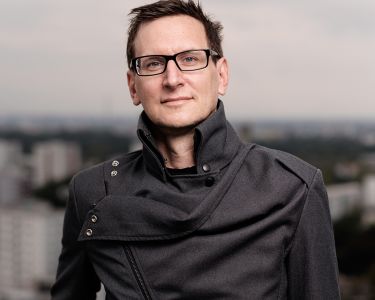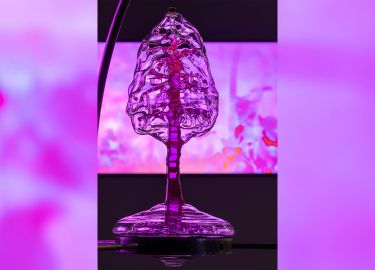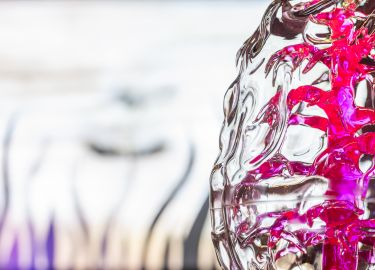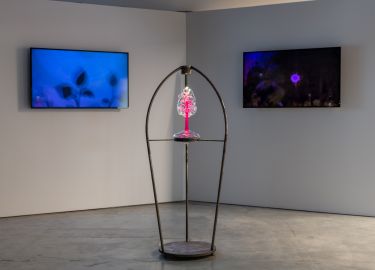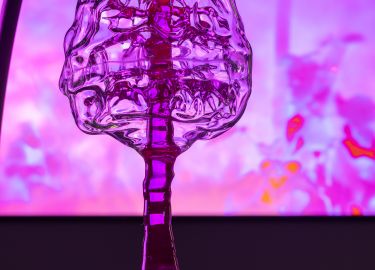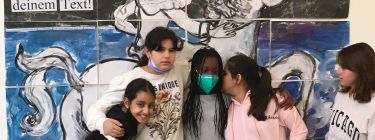
Curable Blindspot of Culture: How Participatory Arts Ignite Positive Change
Ira and Jewell Williams Professor of Romance Languages and Literatures and African & African American Studies at Harvard University and Director of Cultural Initiative at Harvard
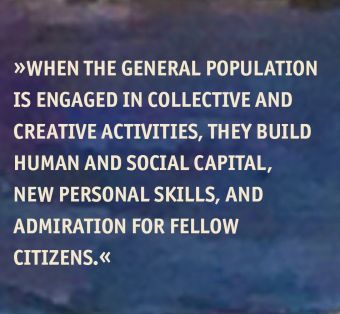
The Curable Blindspot of Culture: How Participatory Arts Ignite Positive Change
How Participatory Arts Ignite Positive Change
Culture is our necessary and renewable resource, the fourth pillar of sustainable development, though we often overlook it. The obstacle, in part, has been the word itself. Culture means two opposite things. One meaning is a heritage of shared beliefs, practices, and places, something to be protected rather than tampered with. This is the sense used by most decision-makers who are trained in the social sciences which privilege patterns over disruptions. The other sense is dynamic and familiar to artists and humanists who disrupt patterns and generate new relationships. One understanding is fixed, making culture either an obstacle to development or a fringe area for decoration and leisure, vulnerable to budget cuts. The other is edgy, experimental, and jealous of personal freedom. This difference in meaning causes a blind spot for both mayors and creatives who see past one another when collaborations are urgently needed to adjust outdated attitudes and behaviours that currently block development toward the SDGs.
Picture above: Copyright: Mannheim Public Library, Copyright Yilmaz Holtz Ersahin and Angelika Senft Rubarth
Today, in a post-pandemic world, we have an extraordinary opportunity to bring these visions together into bifocal projects. Shared beliefs and practices need to be refreshed and updated, as effective leaders know. The vast but under-acknowledged bank of evidence is witness to creativity’s power and potential. This includes a literature review by the WHO of 3,000 studies and an evidence base created by the EU and literally 100s of studies in specific cities. On the other hand, artistic interventions need to take stock of their practical effects, beyond personal satisfaction. Otherwise, we waste the creative resources that make us human. Collaborations will make us better citizens who can re-set our societies after the Covid 19 pandemic exposed habitual exclusions such as life and death inequities. Policies of inclusion in post-pandemic cities can count on participatory arts to foster collective belonging. Arts literacy projects will assimilate immigrants; and immigrant arts will enrich the local offer. (See www.pre-texts.org) The gains will be better security, physical and mental health, economic equity, and care in both senses of loving and taking responsibility for society. In sum, the power of arts as inclusion can energise cities across all dimensions.
The reason is clear. When the general population is engaged in collective and creative activities, they build human and social capital, new personal skills, and admiration for fellow citizens. Collaborations as well as supportive investments will harness the power of participatory arts, which is not the same as entertainment. Entertainment can be enjoyed passively, without engaging the energy of dynamic youth. Youth will build or ravage our cities; they actively participate in civic life or they reject it. And rejection can lead to violence, which simmers during lockdowns and has already exploded in many parts of the world. Our opportunity and obligation is to redirect youthful energy—we cannot extinguish it. Policing and punishment alone have not worked well, nor has single-minded investment in infrastructure. A few examples among many highlight the potential.
1. In 1995 newly elected Mayor Antanas Mockus of Bogota, Colombia faced a city mired in despair, violence and corruption. “Time to bring out the clowns,” counselled his Secretary of Culture. “Good idea,” responded the playful mayor. Twenty pantomime artists replaced twenty corrupt traffic police to shame irresponsible pedestrians and drivers. The shared laughter broke an apparently solid pattern of lawlessness. In the first year, there were 51% fewer traffic deaths. Many participatory arts initiatives followed, along with tax reform, transparency and infrastructural development. But art was the icebreaker. Within two administrations, homicides were reduced by almost 70%; tax revenues increased by 300%. This was “cultural acupuncture,” an approach developed from Jaime Lerner’s “urban acupuncture” for Curitiba, Brazil. Mockus added participatory art-making and accomplished astounding results.
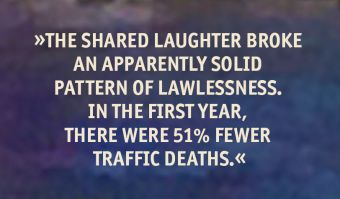
2. Edi Rama became World Mayor of the Year in 2004, mostly for painting the grey city of Tirana in bright colours. It did not solve all entrenched problems, but art did act as a catalyst to rediscover a pride of place and greater respect among citizens. An artist himself, Rama saw colour as more than decoration. It is a structural element to revive the civic spirit. “Beauty was acting like our guardsman… where municipal police, or the state itself, were missing.” This was his winning message in a campaign to become Prime Minister of Albania. Over the last few years, Tirana has made astonishing progress in its urban development, creating an urban forest belt of 2 million trees around the city core where children can plant a tree on their birthday. In 56 months, the city created 56 playgrounds in dilapidated parts of the city that act as gathering places and social connection points for all ages.
3. Broad-based music education has long proved to be a problem-solver, ever since El Sistema was established in Caracas over 50 years ago. By now, almost five million young people in Venezuela have benefitted from classical music training. It won’t make them all professional musicians, but it does teach discipline, focus,
collaboration, and dedication to beauty. Music-making, crucially, keeps vulnerable youth off dangerous streets. Many international projects have imitated this program with notable success.
4. This year Peter Kurz of Mannheim was awarded the World Mayor International Award. Much of his long-term work has involved using the arts to foster intercultural understanding and to regenerate troubled neighbourhoods such as Jungbusch. In Mannheim immigrants make up half of the population and former industries are giving way to new business models focused often on the creative economy. Sceptics about arts interventions sometimes object that they are not inspired, like Mockus, or trained as a painter, like Rama, or an engineer, like Lerner. Yet, Mayor Kurz is not himself an artist. Instead, his talent is to listen and to take small, cost-effective risks on art. One was his support for the School for Oriental Music, a unique initiative that a Turkish musician initiated to gather disaffected youth for rigorous time-consuming and community-building music lessons. This is one of many orchestrated ‘cultural acupuncture’ initiatives through which Mannheim addresses security and education by stimulating creative activities that foster diversity and belonging.
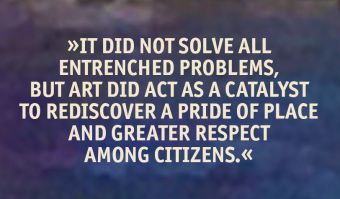
As part of a leader‘s toolbox, participatory arts can play a significant role in addressing the global challenges of SDGs. “Had I understood the power of arts to change behaviour and to drive prosperity, I would have made very different decisions as Minister of Development.” (José Molinas of Paraguay, formerly of The World Bank.) His change of perspective inspires a new “Certificate in Arts and Policy” for city governments in order to engage arts toward achieving a city’s goals, and to articulate particular goals with all the others. Each depends on the articulation: e.g. public health depends on education, transportation, violence prevention, etc. Education depends on public health, transportation, violence prevention, etc. The hybrid virtual and in-person sessions presents existing “Cases for Culture” and then customises co-constructions of new projects for the city’s challenges and resources. The Certificate complements the social science background of most leaders with humanistic thinking that recognises the arts as dynamic vehicles for developing human and social capital. (See https://renaissancenow-cai.org/wp/arts-and-policy/)
In a brief span of time, the Certificate in Arts and Policy consolidates deep European roots of democracy and development. Its people-centred approach can close the short circuit between high investments and low results, through cost-effective investments in art. Why does this work? A short answer is that the arts can include everyone. This means recognising art as the process of making, rather than products. Here participation and inclusion go together. This connection between participation and inclusion structures UNESCO’s broad-based program in arts education and entrepreneurship, “Towards 2030: Creativity Matters for Sustainable Development.”
Who is an artist and who an interpreter? Potentially all of us, to follow Friedrich Schiller who wrote Letters on the Aesthetic Education of Man in 1794. That was during the Terror of the French Revolution. Its shock value at the time was perhaps greater than our current pandemic and social upheavals. Slyly, he asks whether art may be an untimely topic for violent times. His affirmative answer is bold and compelling: Without art nothing changes. Humanity spirals into more violence, death, and despair.
Art is the name of development itself. It rejects inherited paradigms and it dares to experiment with new arrangements. If social science understands culture as a system of shared beliefs and practices, as Raymond Williams observed in Keywords, artists and humanists understand culture differently. It is confrontation with paradigms.
Schiller’s passionate call to action is to outsmart violence by breaking from habit and using frustration as a fuel to make something new, a surprise move, an unexpected creation that gives the maker a sense of autonomy and that stops the enemy in his tracks. This is trial and error—the way science works. And Schiller counts on our natural faculty to be creative. We have a drive to play, a Spieltrieb is his newly minted word. When we recognise the human condition as creative—which is evident precisely in under-resourced areas where people recycle and make-do—art is understood as a vital activity in which we all participate. Framing creativity as everyday resourcefulness to alter materials and relationships acknowledges the dignity of all people. Dignity follows from making because the artist is not a victim. Artists know that they have options and that they make decisions, even inside difficult constraints. This sense of autonomy and freedom within constraints is basic to citizenship. People feel proud of their creations and they respect beautiful things that others make. “Beauty was acting like a guardsman,” Mayor Edi Rama knew, “where municipal police, or the state itself, were missing.” He invited citizens to deliberate about colour and design to paint bright colours over old grey buildings. Even beautiful patrimonies of art, architecture, and monuments are there to be used. They offer historical continuity with precious urban spaces that link the past with the future. During the present COVID-19 restrictions on movement, digital programming has bought these sites of cultural heritage to an expanded virtual public.
Making autonomous choices through artistic practice channels the frustrations that many young people feel in our overcrowded and under-resourced neighbourhoods. Through art they can provoke and criticise in non-violent ways. “Symbolic violence” is another name for art and a pathway around the real thing.
Creativity is what distinguishes our species from other animals. Many are intelligent, but only human beings are imaginative beyond strategic thinking. Knowing this obliges us to create new things and new social arrangements. This is the theme that Josef Beuys made popular to repair the world after WWII when he established Documenta, the most important international art event, celebrated every five years in Kassel, Germany. As we speak, a stage of Documenta is being set for collaborations, because unlike previous editions, the 2022 event will promote community-oriented collectives. Artists have understood their urgent obligation to renovate creative practices and to adopt social and climate challenges. Today, artists, engineers, and educators offer initiatives to leaders who can recognise good bets and take necessary risks. This is the spirit of the early modern Renaissance. When the Medici bet on young Brunelleschi to build a monumental Cathedral dome, other investors scoffed at the folly. But the bet paid off, and the winners included the Medici, the artist and the entire city of Florence. In contemporary Italy, opera trucks are familiar interventions in immigrant neighbourhoods. Examples like these can help to ignite a new Renaissance Now with collaborations that take account of people’s creativity and that generate civic pleasure to keeps us engaged with each other as we face global challenges.
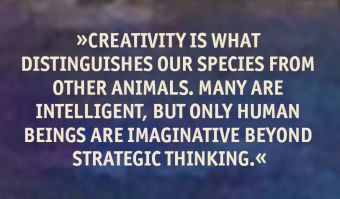
Doris Sommer
Doris Sommer is Ira and Jewell Williams Professor of Romance Languages and Literatures and of African and African American Studies at Harvard University. She directs the Cultural Agents Initiative at Harvard, and the Cultural Agents NGO dedicated to reviving the civic mission of the Humanities. Her projects include “Pre-Texts,” an arts-based training in literacy and citizenship, and Renaissance Now, a forum for rethinking culture in development. Her books include Foundational Fictions: The National Romances of Latin America (1991) about novels that helped to consolidate new republics; Proceed with Caution when Engaged by Minority Literature (1999) on a rhetoric of particularism; Bilingual Aesthetics: A New Sentimental Education (2004); and The Work of Art in the World: Civic Agency and Public Humanities (2014).Sommer’s work span’s Harvard’s Humanitarian & Cultural Initiative at the Mahindra Centre, the Executive Committee of the David Rockefeller Center for Latin American Studies, the American Studies Program, the Committee on Ethnicity, Migration, Rights (EMR); the Centre for Public Service and Engaged Scholarship & Global Health and Health Policy, South Asia Institute, and the Modern Language Association’s Working Group on K–16 Alliances. Recently, she prepared the Brief on Culture for the Summit of the Global Parliament of Mayors. Picture © Harvard Gazette
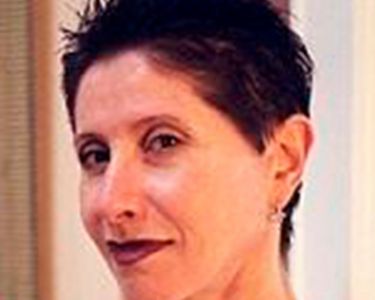
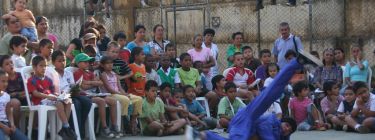
The cocktail of challenges of disadvantaged in crisis
Ruth Daniel, CEO of In Place of War and Honorary Research Fellow at University of Manchester; Teresa Ó Brádaigh Bean, Leader of research activities at In Place of War and Honorary Research Fellow at University of Manchester
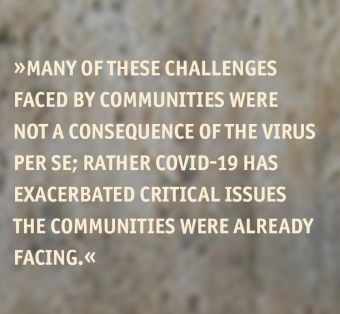
The cocktail of challenges of disadvantaged in crisis
Making the case for the civic role of the creative and cultural ecosystem in a Renaissance
The ongoing COVID-19 Pandemic has had a devastating impact on communities around the world. Whilst in Europe many have enjoyed the cushion of working from home or social protection mechanisms (special benefits and unemployment protection), disadvantaged communities in Latin America, Africa and the Middle East have been left vulnerable on all fronts. Operating in mainly the informal economy or in precarious employment, living in overcrowded housing, lacking access to information or PPE (personal protective equipment), and enduring some of the strictest and militarised lockdowns in the world presented these communities with a cocktail of challenges. This piece builds on the work of In Place of War in sites of conflict in the Global South for over 17 years working with grassroots arts-based peace-building as well as 120 cultural leaders and gives witness to the role of community arts organisations in civic engagement, using the arts to mobilise communities to make positive social change.
Picture above: break dance performance in a sports ground, Medellin, Colombia. Copyright: Leonardo Jimenez
COVID-19 was a further catalyst for community arts-based social mobilisation and civic engagement to tackle immediate issues of food insecurity, lack of sanitation, wellbeing, and public health awareness and school closures. Many of these challenges faced by communities were not a consequence of the virus per se; rather COVID-19 has exacerbated critical issues the communities were already facing. Working in partnership with our network of change-makers, drawing on their local knowledge, existing community relationships and understanding of how best to respond to the pandemic, we supported them in delivering direct, bespoke assistance, determined and led by those located in beneficiary communities. These locally-led processes resulted in a range of responses from the creation of community kitchens to mobile sound systems and online fundraisers and concerts to provide economic assistance to artists and the wider communities. Despite the array of projects, they all reaffirmed our understanding that art can be key in fomenting civic participation and positive societal change.
Despite or because of COVID-19: a new role for social enterprises
This process also demonstrated how, with a small amount of funding, informal, grassroots organis-tions rooted in communities that are often underrepresented in the cultural sector and who can’t normally access funding can lead to long-term positive outcomes. This included the development of sustainable social enterprises. Thus, this invites reflections in the European context and beyond about the importance of embedding participatory grant-making for grassroots arts organisations as a strategy to create a more inclusive and diverse creative ecosystem that supports arts-based sustainable development.
Hunger isn’t in Lockdown: COVID-19 in the Global South
As COVID spread, and lockdowns were imposed globally, our network of change-makers provided grim insights into the impact of COVID-19 on some of the world’s most disadvantaged communities. Here is a snapshot from artists and cultural practitioners on the ground in Latin America, Africa and Asia in April 2020.
MC Benny, Hip Hop artist, Northern Uganda: “People are living in fear, many are testifying that this is worse than a physical war. Our team has already seen that government forces have been using excessive force to enforce lockdowns”
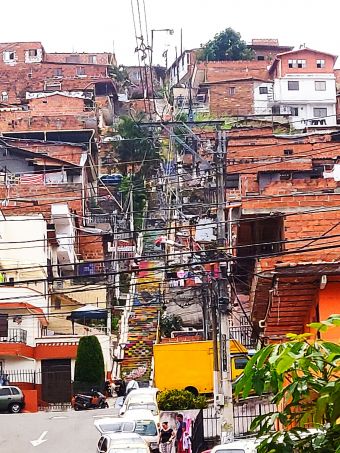
Nathalia Garcia, Elemento Illegal, Medellin, Colombia: “Communities in El Faro, an informal neighbourhood on the outskirts of Medellin where many displaced families forced to flee violence have been severely affected by COVID. The area is home to 400 vulnerable families living in dire conditions, working in informal and precariousemployment. Lockdown has left them unable to generate income and 98% of them are struggling to cover their basic needs with hunger being the most pressing issue. Preventing the spread of COVID in the area is further compounded by lack of basic sanitation and hygiene products.”
Vijay Kumar, India: “There is simply no support from the government, some families are on edge of starvation during these days.” Our team notes, “India has some of the most extremely high-density urban populations, social distancing is simply not an option for most of these people, and the consequences of lockdown are costing lives through hunger and lack of medicine.”
Robert Mukunu, Mau Mau Arts, Kenya: “A young boy was shot by police on the balcony of his home in Kiamaiko, Nairobi, because ‘he was out during the curfew’ which seems like a dark irony that a citizen was killed by police who were ensuring he was indoors to protect him from COVID. Questions still remain unanswered on why the government is charging for treatment of corona-related ailments as well as the use of testing kits and masks donated to the government.”
Re-birth in the midst of lock down? How to leverage support and funding from the Music Industry in crisis conditions
Whilst IPOW’s work has focused on supporting and building networks with grassroots artists in the Global South, the organisation has also developed relationships with commercial music industry partners. During the pandemic, given the devastating impact of COVID on the cultural sector, these organisations were keen to support artists and cultural practitioners. Thus, working in partnership with In Place of War, small grants of $500 to $2,000 were made available to the change-maker network.
Setting up an innovative process for participatory grant-making, locally informed decision-making and implementation.
A call for applications was sent to our change-maker network via Whatsapp in French, English and Spanish, resulting in 45 applications. The application process was open in which applicants had to explain the impact of COVID on their community and their ideas to address these issues. A small panel from the In Place of War Board and team reviewed applications, selected recipients, and funds were distributed promptly, having immediate impact. The overall process took only two weeks, including the due diligence process required to meet charity regulations. Given the geographical spread and diverse contexts in which artists operate, projects ranged from tackling food insecurity through the establishment of community kitchens, bakeries and allotments, public awareness campaigns about preventing the spread of COVID-19 using visual arts, and issuing grants to artists.
Change-Maker case studies
Delhi, India
Vijay Maitri is a theatre practitioner from the Kathputli Colony in Delhi, India.
Due to lockdown, this community of 12,000 performing artists (the lowest caste in India, considered to be the criminal caste) who live in slum conditions, were unable to earn money and therefore unable to afford any food or access PPE.
Vijay organised a food and PPE distribution centre in the neighbourhood and using the IPOW grant distributed food and PPE to 12,000 people.
Picture right: Vijay organising food distributions, Copyright: Vijay Kumar
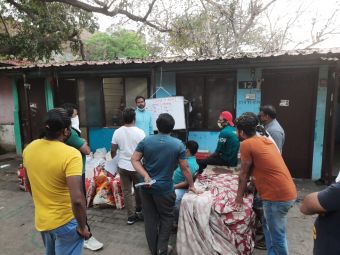
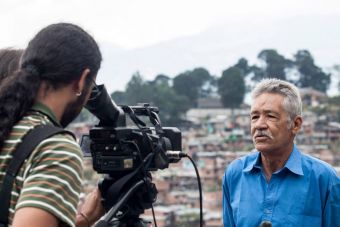
Medellin, Colombia
Alejandro Rodriguez is an MC and music producer and part of Old Guns, a hip hop collective from Comuna 13 in Medellin, Colombia.
Comuna 13 is a disadvantaged neighbourhood suffering from high levels of poverty and violent gangs. During the lockdown many residents could not make a living as they work in the informal economy as street vendors, builders, collecting rubbish and recycling. Thus, lockdown left them struggling to access food and essentials.
Picture left: Ciudad Comuna interview, Copyright: Ciudad Comuna
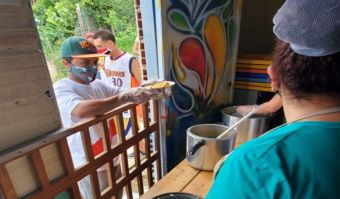
With the In Place of War grant, Old Guns decided to develop a community kitchen and allotment to address the issue of food insecurity in the area. They secured a building, partnered with a local community organisation, got permission from the gang leader who controls the area and enlisted an army of volunteers to work in the kitchen. During lockdown, the kitchen served 750 meals a week to vulnerable members of the community using produce from the community allotment.
Picture left: Kitchen serving meals during lockdown, Copyright: Alejandro Rodriguez
Caracas, Venezuela
Tiuna El Fuerte is an arts organisation located in El Valle, Caracas, Venezuela.
People living in tower blocks in the surrounding neighbourhood felt isolated and disconnected during lockdown, resulting in a decline in mental health.
Using the grant from In Place of War, Tiuna El Fuerte set up a mobile sound system and radio station, which travelled across the streets playing music and sharing messages over the sound system from loved ones across the community, helping people feel less isolated. They estimated that they reached over 20,000 people in two weeks.
Picture right: Tiuna El Fuerte’s Radio Verdura in the streets of Caracas, May 2020. Copyright: Tiuna El Fuerte
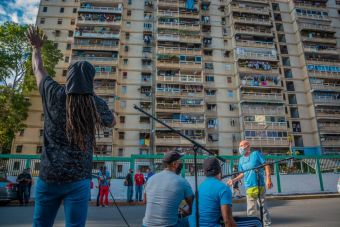
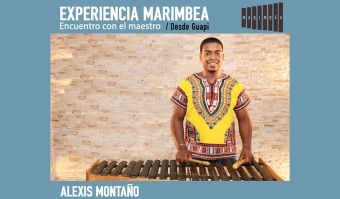
Cali, Colombia.
Marimbea is a cultural organisation based on the Pacific coast that works to promote Afro-Colombian culture through tours, performances and workshops. Due to the pandemic and lockdown, the community were unable to work and lacked access to basics. Using a grant of $1,000, Marimbea organised a series of online events, performances and workshops, paying the artists to participate and charging audiences to engage with the content. The events generated $2,000 in revenue and led to the development of a new digital content platform offering cultural experiences online.
Picture left: Promotion material for online workshop, Copyright: Marimbea
Reflections: What to learn for the idea of a Renaissance
These case studies provide interesting insights into the civic role of arts organisations in mobilising to address critical needs of local communities during the pandemic. This is hinged on a number of features. These organisations are committed to a place; often taking place in public spaces such as playgrounds, community centres, parks and schools, it is part of and shapes the local landscape. It is rooted in and part of their communities and thus artistic practice is designed by and for those communities. Given this, the art responds to the needs and aspirations of this community, and nurtures and celebrates the talent within the community.
Civic participation and artistic practice can not be divorced
This is a people-centric and local approach using artistic practice to facilitate human development, promoting positive values and social interaction and building communities. Given this, civic participation and artistic practice cannot be divorced: they are enmeshed and develop a symbiotic relationship. Art is a tool to engage communities which through participation leads to new artistic work and a more inclusive and diverse creative ecosystem designed to develop the community.
Indeed, one of the commonalities between these responses to the lockdown was that the organisations improved their standing within their local communities. Their work during the pandemic has elevated their status and visibility within the community and beyond. The creation of Trackside’s bakery and Marimbea’s digital cultural experiences are representative cases of this.
Picture right: Theatre performance about disability in Northern Uganda, Copyright: Mono Grande
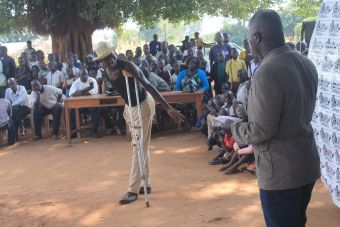
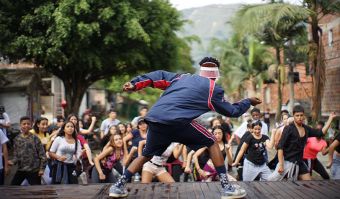
Radically nurturing artistic talents—and their aspirational community
We believe that, as in the case of our change-maker network, identifying and nurturing existing talent and projects in communities is key in developing genuine arts projects that respond and evolve to meet the needs and aspirations of the local community. Thus, rather than prescribing themes and agendas, offering support for the evolution of organic arts based community is of paramount importance.
Picture left: Dance class in Medellin Credit_Mono Grande, Copyright: Mono grande
Be innovative about funding social innovation
Similarly, developing more inclusive and open funding streams to enable grassroots, informal organisations to access funds to create civic arts projects is also key. We adopted a participatory grant-making model that allowed art organisations to develop responses that were tailored to their experiences and knowledge of their communities. They were not constrained by our preconceptions of what was the most critical need and this is clearly reflected in the range of responses the organisations developed. Small grants were distributed to informal groups and collectives as well as local NGOs which we were able to award without the need for clumsy and prohibitive due diligence processes, whilst crucially complying with charity commission regulations. Thus, in sum, the pandemic has illuminated the primordial role that local grassroots arts organisations can play in addressing critical issues facing communities, especially in times of crisis. They can be responsive and resourceful, generating immediate and real impact with little funding. This therefore invites us to rethink how we understand community arts projects beyond short-term interventions that respond to fleeting policy agendas and political strategies.
How can the cultural and creative sector foment grassroots, locally-led civic arts that showcase and celebrate talent in towns and cities in Europe both during and beyond the pandemic? How can we create inclusive and accessible funding processes so that such informal groups can develop and sustain their practice whilst generating long-term positive outcomes?
The creation of diverse networks and long-term relationship-building connecting commercial partners, governments, formal cultural institutions and grassroots collectives is key to fostering long-term arts-based social transformation in our communities—a transformation the green and digital transformations cannot do without—like, for example, the New European Bauhaus, the latest initiative of EU President von der Leyen highlights. Learning from the Global South how to empower arts-based social transformation in communities might strengthen a Next Renaissance in Europe while preventing one of its major risks: Of being a Revolution for the Privileged.
Links
Creativity Conquers COVID- A short documentary about the how IPOW’s change maker network responded to the COVID lockdown
Ruth Daniel
Ruth is a multi-award winning CEO, activist and change-maker. Inspired by the transformative use of hip-hop in the drug cartels of Medellin, Colombia, when a young MC said: ‘If it wasn’t for hip-hop, I would be dead. Hip-hop gave me another option and I’m truly thankful for that.’ Ruth believes art has a capacity to make change in the toughest of contex From guitarist at the age of 8 to record label owner, band manager, fundraiser, international cultural activist, entrepreneur, educator, influential speaker (TEDx) to prestigious award winner within a national arena (Social Enterprise of the Year & Manchester Woman of Culture to name a couple), Ruth’s passion to empower people to build their own positive futures through creative entrepreneur programmes, the development of cultural spaces and artistic collaboration shows no boundaries in terms of fields of work.
Picture © Katie Dervin
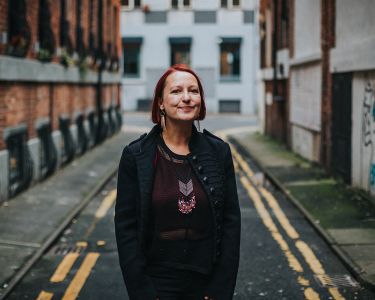
Teresa Ó Brádaigh Bean
Teresa Ó Brádaigh Bean is head of research and learning at In Place of War, a global charity that works to support grassroots arts based social change processes in sites of conflict. Her research interest and practice has focused on hip hop as a social movement, grassroots arts education, creative entrepreneurship in sites of conflict and community arts based peacebuilding. She has undertaken a number of research project exploring arts based social change processes mostly recently as a researcher on the the Art of Peace led by Prof. Oliver Richmond at the University of Manchester. She has played a key role in developing In Place of War’s education programmes. As a qualified teacher, she wrote CASE (Creative and Social Entrepreneur Programme). CASE was one of the five shortlisted finalists for the inaugural UNESCO-Bangladesh Bangabandhu Sheikh Mujibur Rahman Creative Economy Prize in 2021. It was awarded the Outstanding Contribution to Widening Participation at the University of Manchester’s Making aDifference Awards in 2017. The programme has been delivered in 14 countries including Bosnia, Uganda, Colombia, South Africa and the MENA. Teresa is an Honorary Research Fellow at the University of Manchester and a member of the Global Coalition on Youth, Peace and Security (GCYPS) a UN Inter-Agency Network.
Picture © Alexander Butcher
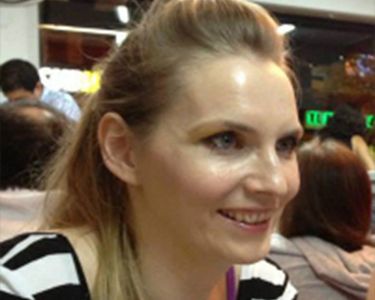
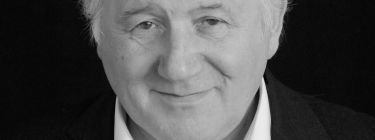
Renaissance 3.0
Artistic-scientific Director and CEO of ZKM Center for Art and Media, Karlsruhe and Director of Peter Weibel Research Institute for Digital Cultures at University of Applied Arts, Vienna
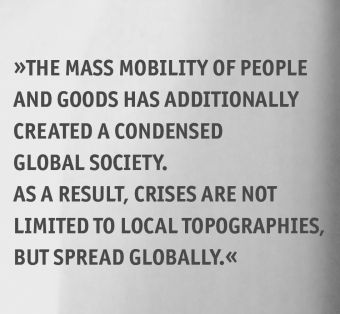
Renaissance 3.0
A scenario for art in the 21st century
The turn of the 21st century has been marked by a series of crises on a global scale. Through the infosphere, that electromagnetic envelope that surrounds Planet Earth and which we have been using for communication since the mid-19th century through radio technology, from telephones to satellites, a global society emerged in the course of the 20th century. News that used to take months from source to receiver—of earthquakes to stock market fluctuations—is now distributed almost simultaneously across the globe. The mass mobility of people and goods has additionally created a condensed global society. As a result, crises are not limited to local topographies, but spread globally. From the climate crisis to the migration crisis, from the financial crisis to the COVID-19 crisis, we are witnessing ever more profoundly shattering consequences. Principles of our civilisation built on the successes of humanism and the Enlightenment—for example, the universalism of human rights, equality of race, gender and age before the law, autonomy of the individual, freedom of the press and arts, democracy—are increasingly being challenged. Due to the climate crisis, the overall habitability of Planet Earth by humans—and thus humanity’s ability to survive—is being called into doubt. Mass migrations in the coming decades could therefore radically change the face of the Earth and the social systems that have
Picture above: Peter Weibel, Copyright: ZKM | Zentrum für Kunst und Medien Karlsruhe, photo by Christof Hierholzer
prevailed up to now. Therefore, it is necessary to propose a navigation system that prevents the failure of the mission of humanity on the good ship Earth. One of the possible scenarios for the future seems to us to be the revival of one of the greatest moments in human history, namely the Renaissance.
Most people think of the Italian Renaissance (15th, 16th and early 17th centuries) when they hear the term Renaissance, which stands for an era that surpassed anything that had gone before in terms of freedom, progress and discovery. However, it is important to note that there was an Arab Renaissance before the Italian Renaissance, from 800 to 1200, which has only come into focus in recent years.1
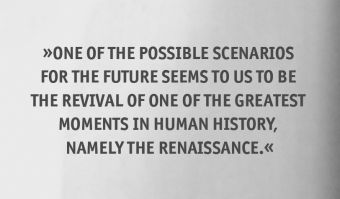
Italian Renaissance
The Italian Renaissance stands for a cultural revolution that ushered in a new attitude to the world and to humanity that was decisive in the history of the Western world. For many people, the Renaissance is regarded as a time of new beginnings, in which art and science flourished as never before and as never since. An example of this could be the painting La scuola di Atene (The School of Athens) by the painter Raphael, which he realised in the Stanza della Segnatura of the Vatican from 1510 to 1511. The title of this painting illustrates a central important aspect of the Renaissance, namely the rebirth of antiquity. Similarly, the rediscovery of Lucretius‘ ancient text De rerum naturae (On the Nature of Things) influenced artists like Botticelli, but also scientists like Bruno Giordano and Galileo Galilei. The last existing copy was discovered in a German monastery in 1417. Erwin Panofsky pointed out in his seminal work Idea: A Concept in Art Theory (1924) that the terms idea and type originated in the philosophical vocabulary of the Greeks, from which developed the cult of the ideal that prevailed in Europe until the days of Romanticism. That is why German masters such as Albrecht Dürer, and the three Nuremberg masters who worked with perspective representation——Lorenz Stöer, Wenzel Jamnitzer and Johannes Lencker—should also be considered.Decisive for the Renaissance, however, is Leonardo da Vinci’s quote, „Se la pittura è ’scienza o no,” with which he opens his famous manuscript Trattato della pittura (written circa 1490, published 1651). The claim was quite clear: „Painting is a science.” Renaissance, then, is the scientification of art. That is a central aspect of the Renaissance.
Up until the Renaissance, artists were considered craftsmen, belonging to artes mecanicae. In the Renaissance, they increasingly saw themselves as representatives of the artes liberales, i.e. as scientists and scholars. Renaissance artists repeatedly portrayed themselves as scholars, for example by featuring compasses, mirrors and small globes in their self-portraits as well as depicting their tools of the trade: canvases, brushes, perspective devices, and so on. Federico Zuccaro staged himself in his self-portrait as a reader of a book. These artists were concerned with optics and rays of vision and the theory of proportions. Piero della Francesca was, as it were, a calendar mathematician. He was interested in the doctrine of polyhedra.
A second central aspect of the Renaissance was the discovery of the individual. Whether in art, science, economics or politics, it was individuals who devoted themselves to exploring new horizons, new spaces at their own risk, be it the exploration of the seas by Columbus and Magellan or of celestial bodies by Galileo. The artist, the navigator, the explorer discovered new worlds, often against prevailing ideologies and doctrines. The Renaissance was thus the epoch of the triumph of individuality and this triumphant march has continued to this day. From the architecture of a Palladio to Titian, from Leonardo da Vinci to Giulio Romano, from Benvenuto Cellini to Michelangelo, we observe the the discovery of the individual.
Art as science and the expression of the individual’s abilities are thus the two most important aspects of the Renaissance for the future of art.
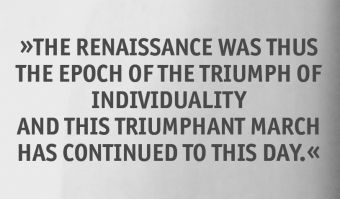
Arab Renaissance
But the Italian Renaissance was not the first scientification of art. The Arabic Islamic Renaissance occurred between 800 and 1200. The Banū Mūsā brothers created programmable musical automata around 850. Ibn al-Razzuz Al-Jazari wrote the book Compendium on the Theory and Practice of the Mechanical Arts around 1200. From Baghdad to Andalusia, Arab artists and scholars, such as Ibn Khalaf al-Murādī and Abū Ḥātim al-Muẓaffar al-Isfazārī, rediscovered and advanced Greek and Byzantine traditions. For example, the term algorithm comes from a Latinisation of the name of the Arab scholar Abu Jafar Muhammad ibn Musa al-Chwārizmī. As Hans Belting has documented in Florence and Baghdad, Abū ‚Alī Ibn al-Haiṯam (965-1040, known in the West as Alhazen) wrote Kitāb al-Manāẓir. His work was translated into Latin in the 12th century and contains fundamental studies on the propagation and refraction of light. The reception of Ibn al-Haiṯam’s theory of light and vision triggered one of the most exciting chapters in the history of Western art. Alhazen can be considered the inventor of the camera obscura and the forerunner of the invention of perspective. Perspectiva was the Latin title of his Arabic work on optics which was later replaced by the Greek term Optics and then again by the Latin Opticae Thesaurus (1572).
Renaissance 3.0
In this respect, the Arab Renaissance was the first, the Italian the second, and now in the 21st century there are convincing signs that we are experiencing a third Renaissance. In contrast to the two, relatively localised Arab and Italian Renaissances, the latest manifestation is global. Artists from China to Chile form a new generation of art-based research and research-based art. New works of art and scientific theories are emerging that do not only refer to the historical achievements of the preceding renaissances. Clearly, there are continuations of lines of tradition. For example, façade decorations by Falconetto in Verona foreshadow projection mapping on public buildings. Likewise, Paolo Veronese’s frescoes can be seen as precursors to immersive environments. In the future, new scientific disciplines, especially expanded forms of the life sciences, will determine our lives. The new society will therefore not only be about automata and robots; there will also be a shift from the mechanical and machine-based renaissances: that is, from hardware, to the new renaissance of software, programming, codes.
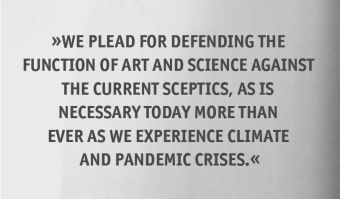
In this respect, genetics, molecular biology, all forms of the new life sciences, artificial intelligence, quantum optics, climate research, health care, the infosphere, the data society, questions of cyborg feminism (see Donna Haraway and Joanna Zylinska) will be central.
In the 21st century, there is a new basis for the convergence of the arts and sciences. Artists and scientists share a common „pool of tools“. Tools that dentists use, for example, small cameras that illuminate the oral cavity, are also used by artists. The same computers and screens are used by artists and scientists, as are algorithms and data networks. Mathematical equations slide over into genetic entities, both for physicists and artists, and geometric entities and fluid objects transform into data, into data curves, both in science and in art.
As long as art remained within the horizon of visible things that our natural organ, the eye, captures, it was difficult to build a bridge to science which, since the 17th century, has captured the world with instruments and apparatus, from telescopes to microscopes. With such apparatus, science opened the door to the previously inaccessible res invisibiles. As long as art refused to use such apparatus, it was fundamentally different from science. Art ended at the limits of natural perception. Science begins where natural perception ends, that is, beyond natural perception. With the rise of media since photography (circa 1840), media art also uses apparatuses and algorithms like science. This is the new basis of the convergence of science and art for a new renaissance.
The art of the 21st century will be dominated by this Renaissance 3.0 and will thus face the many challenges of humanity. One of these challenges is that the function of art and science to give meaning to the rerum naturae (Lucretius)—to the things of the world and nature, and to human beings—is being reinstated at this historical moment even as the function of science is being doubted. Hegel famously claimed that after religion and art, it is philosophy that recognises the absolute, that is, that gives us meaning and knowledge. We plead for defending the function of art and science against the current sceptics, as is necessary today more than ever as we experience climate and pandemic crises. The Renaissance 3.0 project will open the general public up to an unprecedented horizon of innovative works of art and, as the Italian Renaissance achieved, a new attitude towards the world and the future of symbiotic life of all living beings on Planet Earth.
References
1 Siegfried Zielinski, Peter Weibel, Allah’s Automata. Artifacts of the Arab-Islamic Renaissance (800-1200). Ostfildern: Hatje Cantz 2015
Peter Weibel
Peter Weibel is the artistic-scientific director and CEO of the ZKM Center for Art and Media in Karlsruhe and the director of the Peter Weibel Research Institute for Digital Cultures at the University of Applied Arts in Vienna. He is considered a central figure of European media art on account of his various activities as an artist, theoretician, and curator. He publishes widely on the intersecting fields of art and science. His career took him from studying literature, medicine, logic, philosophy, and film in Paris and Vienna to working as an artist and lecturer and then to heading the digital arts laboratory at the Media Department of New York University in Buffalo from 1984 to 1989. He later became the founding director of the Institute of New Media at the Städelschule in Frankfurt from 1989 to 1994 and professor of media theory at the University of Applied Arts in Vienna from 1984 to 2011. He was the artistic director of the Ars Electronica festival in Linz from 1986 to 1995, the Seville Biennial (BIACS3) in 2008, and the Moscow Biennale of Contemporary Art in 2011. He commissioned the Austrian pavilions for the Venice Biennale from 1993 to 1999 and was the chief curator of the Neue Galerie in Graz from 1993 to 2011. Picture © ZKM | Zentrum für Kunst und Medien Karlsruhe, photo by Christof Hierholzer

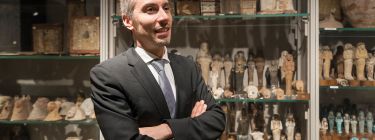
A millenary contemporaneity
Prof. Dr. Christian Greco, Director of Museo Egizio; Luca Dal Pozzolo, Director of Cultural Observatory of Piedmont at Fitzcarraldo Foundation, Turin
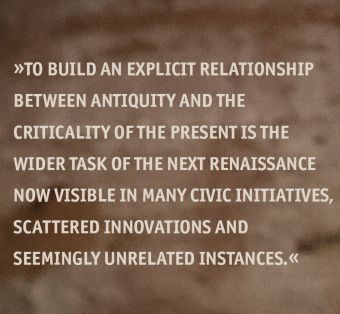
A millenary contemporaneity
The Egyptian Museum of Turin as a role model for societal dialogue and design of a desirable future
Archaeological museums have a great potential to express in the contemporary world, in showing how ancient societies have reacted to the challenges of sustainability and of their relationship with the climate, and how they have constructed cultural identities within an immense range of alternative ways of life and modes of thinking. To build an explicit relationship between antiquity and the criticality of the present is the wider task of the Next Renaissance now visible in many civic initiatives, scattered innovations and seemingly unrelated instances. This piece explains how this full vision is assumed by the Egyptian Museum and how it enriches with its cultural contribution of historical heritage the conceptual alternatives for the society at large in the design of a desirable future.
Heritages´ role for the future in crisis
As has been pointed out by anthropologists and sociologists, the present time has taken on an inflationary dimension which tends to overlap with the past and extends into the future, depriving it of its novelty and possible change: a formless and intrusive aorist that hinders the perception of the depth of history and the possibility/need for a different future. In this context, history has lost its role as the privileged key to interpreting society but, at the same time, the pandemic has highlighted the extreme fragility and uncertainty of a present that is anything but stable and predictable, furrowed by sudden fractures that open up disturbing trajectories. Moreover, a sneaking feeling of nostalgia for the pre-pandemic period and a recall to a presumed previous normality are all signs of how difficult it is to look straight at the heart of the current critical situation and imagine a possible new design for the future.In this condition, the crisis that has profoundly affected museums and cultural heritage as a result of the lockdowns runs the risk of being read from a reductive economic point of view, as the loss of an entertainment offer, the downsizing of a decisive asset of tourism, the economic damage by the suspension of activities.
Although all this is highly critical for the economic sustainability of museums, it is necessary to focus on the contribution and the cultural mission that museums and cultural heritage are able to offer in order to emerge from a crisis that shakes the 20th-century roots of our European societies.
On the other hand, at the international level, the idea that museums are theatres of memory where local and global identities are defined, and where different visions of the past and present meet the future, is now shared. This is precisely one of the central nodes to nurture a new impetus to address the current challenges to their complexity, and museums, libraries and cultural heritage are the privileged places to inhabit, share and structure the crossroads between multiple identities, new constructions of citizenship and paradigms for social, economic and cultural sustainability.The need to recover the perception of the depth of time and of a future that is to be built through the choice of alternatives is today one of the great challenges that museums and cultural heritage can help to address, provided they are radically transformed: overcoming the concept according to which artefacts are exhibited and separated from their historical context, showing them as objects of particular beauty. Isolating them from their original context does not allow us to interpret an era.
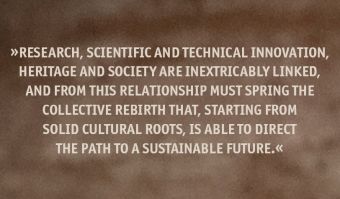
All this implies an epochal passage from a logic of relationship with the public centred on the exhibition, to a dimension of producers of content, both for the public in presence and for the public at a distance as the pandemic has shown.
Although there’s no better way to enjoy heritage than in person, not even with the most sophisticated digital technologies available, museums and cultural heritage can no longer be understood primarily as physical containers to be filled with tickets, but as cultural publishers, capable of graduating their reach and disseminating cultural products on all possible supports towards the public in presence, the distant public, schools, universities, civil society, sewing up the past with the dimension of the future.
Innovating the futures´ context for heritage: The Egyptian Museum's commitment
At this decisive point in time, the wider aim is to perceive museums as laboratories of innovation, fundamental for the harmonious development of society, and as reference institutions for the construction of contemporary knowledge that must now face new challenges. Only in this way will we truly give voice to what Article 27 of the Universal Declaration of Human Rights, approved on December 10, 1948 by the General Assembly of the United Nations, clearly reminds us. Research, scientific and technical innovation, heritage and society are inextricably linked, and from this relationship must spring the collective rebirth that, starting from solid cultural roots, is able to direct the path to a sustainable future.
The Egyptian Museum of Turin is leading in such innovations of the narrative of its contents and experimenting with new ways of relating to its public. Below is a brief description of some of the research guidelines inspired by the approach described above and the related actions that characterise the daily work of the museum.
The alliance between science and archaeology
The places that preserve the vestiges of the past can function as laboratories of innovation, experimenting with new techniques of investigation, through which it is possible to ‚interrogate‘ the objects in different ways. In this field, a real dialogue between humanists and scientists can produce truly innovative results, combining the potential offered by modern science with the questions suggested by objects but still unanswered. The time has come to introduce what we could call a digital humanism in which archaeologists, anthropologists, architects, historians, philosophers, neuroscientists, and psychologists work side by side with chemists, physicists, and computer experts to arrive at the definition of a new semantics that allows us to understand and process the complexity of reality. Starting from, for example, the exhibition Invisible Archaeology, the Egyptian Museum offers the heritage of questions, acquisitions, hypotheses and problems to be faced and explained to different audiences. The alliance with science for the reconstruction of the complexity of life and everyday life does not only imply a low invasiveness of the investigation and delicacy in the impact on the finds (a factor of absolute importance) but also the sharing of the knowledge and awareness of the public distant eras.
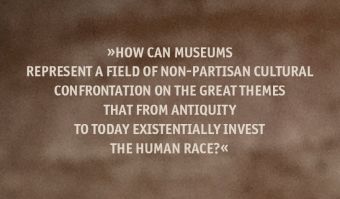
Science and the sacredness of life
The scientific investigation does not only concern objects and findings of material culture, but puts at the centre of its diagnostics life itself through the investigation of mummies and human remains that represent deposits of valuable information on lifestyles, diseases, genetic makeup, and so on. For the Egyptian Museum it is necessary that these investigations and analyses be returned to the public as a positive approach against the objective risk that every exhibition and every museum runs: the evocation of the gaze of the Gorgon that petrifies every object on which it rests. Fighting the dehumanisation of the mortal remains of life, degraded to crystallised relics, no longer worthy of the pietas that was among the reasons for their coming into our presence, is an ethical commitment assumed by the Museum, starting with the debate on the appropriate way to display human remains. Explaining how scientific and genetic investigations with similar methods can be applied today—not only to lives extinguished thousands of years ago but also to the recent deaths of migrants at the bottom of the Mediterranean Sea in order to give them back their names and identities—opens novel societal questions, rooted in the distant past and facing our future and that of our children.
The Egyptian museum as part of a living geography
An archaeological museum dedicated to Egypt runs the risk of being placed in a subsidiary temporal sequence—before the Greeks—but in an ancient geography, no longer related to contemporaneity. Precisely to prevent this possible interpretation, the policy of recent years has focused—also with promotional and marketing initiatives—on the relationship between the museum and Egyptian, Arabic-speaking and African communities in Italy and Europe, to allow opportunities for cultural recognition and pride, for in-depth studies of history and for comparison between places of origin and residence. Egypt is not only a region of history, or a place of excavation and scientific cooperation with which the Museum shares intense exchanges, but one of the most influential countries in the geopolitics of the Mediterranean and an inevitable point of reference for thousands of new citizens. An effective reception policy and the construction of an intercultural society are also based on the recognition of the cultural values of others, on their valorisation, on the possibility that cultural heritages can be reciprocally known and shared, negotiated in their implications and underlying values, and not used to build oppositional, exclusionary identity exoskeletons based on the denial of the other.
The contemporaneity of the past.
The commitment to proposing innovative trajectories, in extreme synthesis, is aimed at making evident to the different audiences—with every, narrative, literary and technological instrument available—how archaeology, probing ancient time, contributes to questions about and redefines the present. This is a necessity as well as a challenge to museums if they opt to be a driver for the Next Renaissance Europe: How can museums represent a field of non-partisan cultural confrontation on the great themes that from antiquity to today existentially invest the human race? The most recent one is the overwhelming transformative power of our societies, which puts at risk the sustainability, not of the planet but of the human species in its development trajectories. The Egyptian Museum hopes to be an inspiration and living lab for museums across the globe, extending here and now an invitation to collaborate and co-create the future of museums for the future of a resilient society. In fact, the scientific investigation in archaeology is one of the most interesting frontiers in the challenges of contemporaneity.
Luca dal Pozzolo
Luca Dal Pozzolo, 1956, Architect, co-funder and responsible for Research of Fitzcarraldo Foundation. From 1998 is Director of Piedmont Cultural Observatory and member of the Scientific Committee of CCW, Cultural Welfare Centre and Member of the cultural Commission of the European Institute of Design (IED). He teaches in Bologna Economic Faculty, (Regional Cultural Policies), in Politecnico di Torino (master in museography) and in Lugano, Master in Advanced Studies in Cultural Management.He designed many museum’s exhibitions and cultural institutions and published many articles and books on cultural economics, museums and Heritage, (Esercizi di sguardo, 2019, Il patrimonio culturale tra memoria, lockdown e futuro, 2021), and is directing the book series Geografie Culturali, for the Italian publisher publisher Editrice Bibliografica.
Picture © Fondazione Fitzcarraldo
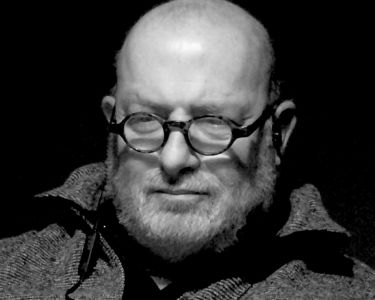
Christian Greco
Born in Arzignano (VI) in 1975, Christian Greco has been Director of the Museo Egizio since 2014. He managed a refurbishment of the museum building and a renovation of its galleries, completed on March 31st 2015, whereby the Museo Egizio was transformed from an antiquities museum into an archaeological museum. Trained mainly in the Netherlands, he is an Egyptologist with vast experience working in museums. He curated many exhibition and curatorial projects in the Netherlands (Rijksmuseum van Oudheden, Leiden; Kunsthal, Rotterdam; Teylers Museum, Haarlem), Japan (Okinawa, Fukushima, Takasaki and Okayama museums), Finland (Vapriikki Museum, Tampere), Spain (La Caixa Foundation) and Scotland (National Museum of Scotland, Edinburgh).While at the head of the Museo Egizio, he has set up important international collaborations with museums, universities and research institutes all across the world. Christian Greco is currently teaching courses in the material culture of ancient Egypt and museology at the University of Turin and Pavia, and he is Visiting Professor at the New York University in Abu Dhabi. Fieldwork is particularly prominent in Greco’s curriculum. For several years, he was a member of the Epigraphic Survey of the Oriental Institute of the University of Chicago in Luxor. Since 2011 he has been co-director of the Italian-Dutch archeological mission at Saqqara. Greco’s published record includes many scholarly essays and writings for the non-specialist public in several languages. He has also been a keynote speaker at a number of Egyptology and museology international conferences.
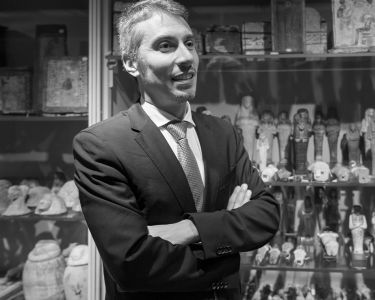
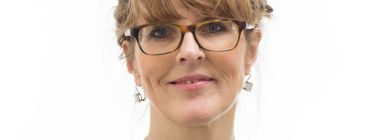
Climate and Culture united in crisis – or in the Next Renaissance?
Director of Julie´s Bicycle, London
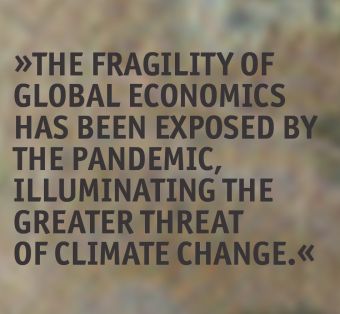
Climate and Culture united in crisis – or in the Next Renaissance?
The Green and The Game changer
The COP26 global climate talks failed to commit to global temperature limits of 1.5 degrees warming, or to establish financial mechanisms to ensure climate justice is given the attention it richly deserves. Global climate governance has not yet succeeded in building consensus for rapid action in spite of the Paris Agreement.7 Perhaps the real challenge is found in root metaphors and their narratives—nature as machine, hostile, to extract, improve, sell, or sentimentalise. The story of climate change is in the buried histories of human and nature conquest, anchored in cultural values of human supremacy. The climate crisis as a cultural crisis, the consequence of myths and stories that permeate society in profoundly subtle ways.
The fragility of global economics has been exposed by the pandemic, illuminating the greater threat of climate change. Ambition to take action has surged across communities and business—the sheer volume of net zero commitments has potential to profoundly change our world —though only if the pendulum swings away from offsetting to absolute greenhouse gas reductions, especially in wealthy economies. And COP26 has bolstered net-zero targets by tightening governance for
carbon trading rules. Up until now cultural policy has, by and large, been oblivious to the encroaching climate crisis, rarely invoking ‘externalities’ from nature (i.e. clean air, green space, carbon profiles), or cultural rights, safety and social inclusion, profoundly affected by environmental conditions. This is true at every level, though city policy is more progressive than national policy, as are smaller institutional commitments. New ambition in the cultural sector is creating conditions for good climate governance.
The arts, like any other sector, have an ecological footprint and Julie’s Bicycle (JB), founded in 2007, began with a focus on the sector’s impacts, and ways to work within the ecological constraints of our planet. Unleashing the energy of the creative community and championing values that restore our sense of belonging within nature, was the real objective. Beyond the arts, the potential of the
creative industries to influence change—design, advertising, film, media, fashion—is huge. JB, which specialises in the arts, has translated the climate crisis into everyday currency with sector-specific expertise and resources that inspire words and action. Our premise is that doing empowers the arts to champion ambitious climate action across civil society. Working closely with the UK music industry, JB generated a methodology for greenhouse gas emissions analysis, carbon calculators for creative activities (buildings, tours, festivals, productions) that are used across the globe (5,000 current users of which about 2,000 are international).
Over the last decade, Julie’s Bicycle has expanded into performing and visual arts and museums, blending cultural and scientific knowledge for cultural practice to serve the planet.
Culture as an ecosystem: Arts Council England
Culture, just like any other sector, is an ecosystem: changes to one part are felt by all. Climate action needs to be tackled eco-systemically, including changes to policy and investment to align international frameworks. These goals are clear: net-zero carbon, green economy and climate justice. In 2012, Arts Council England (distributing £507million in 2019/20) embarked on the largest environmental literacy programme for culture anywhere in the world, making environmental requirements a funding condition. The backdrop was a bigger policy moment: the 2008 UK Climate Change Act. All Arts Council’s National Portfolio organisations (some 828 receiving core funds over multiple years) were asked to measure environmental impacts using JB’s Creative Green tools and have a policy and action plan. The data collection and policies formed a small part of a rich programme of research, resource development and knowledge-sharing evaluated annually. JB was initially
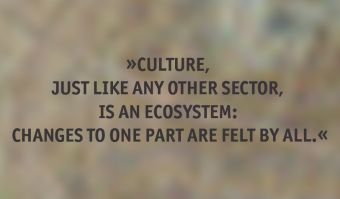
contracted for three years; by the time we complete the current contract (2023) the programme will be over a decade old. Results show an annual 4.5% reduction in energy use across 1,200 organisations, equivalent to over £16million in energy savings, with improved wellbeing and creative inspiration. Over time the partnership has got more demanding; 2018-2022 outputs include setting science-based targets for Arts Council’s largest energy users, 30 major institutions comprising 80 sites, which collectively reduced emissions by 18% in 2019-20.
A decade of data-gathering and collective cultural learning has generated credible and robust evidence, which makes a good case for scaling action. Starting from the basics—carbon footprints—the Arts Council’s deceptively simple policy is demonstrating how a sustainable cultural sector might work.
This vital perspective on culture, seen through the lens of our environment, has stimulated debate and passion, and catalysed a dialogue about the purpose of the arts more widely.
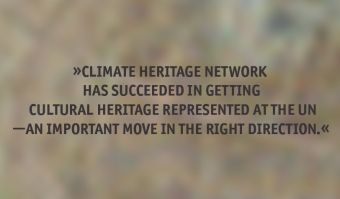
The International Perspective
Arts Council England’s intervention is only one, albeit effective, approach. Scotland and Wales, devolved nations with their own funding bodies, have established inspiring programmesthat combine accountability with exciting creative content. However, internationally, there is an urgent need to build environment into national arts policies. JB’s 2014 research partnership with the International Federation of Arts Council and Culture Agencies (IFACCA) recommended that national cultural policies explicitly reference environmental sustainability and build a global network to exchange ideas and resources with regional centres of excellence. The arts are hampered by a lack of data to underpin cultural policy, a gap which also prevents cultural activists from leading solutions and influencing major climate decision-makers. Climate Heritage Network has succeeded in getting cultural heritage represented at the UN—an important move in the right direction. In 2017, frustrated at the glacial pace of policy change, JB and World Cities Culture Forum, a network of global cities, developed a project for culture leads to connect to their environment counterparts in government and align goals. In many cities climate action is much more ambitious than national ambitions but there is patchy read-across of national cultural policies at this level, notwithstanding some inspirational examples.
Where are we now?
In the 6 months preceding COP 26 JB returned to national policy to understand progress aligning national culture policy with the Paris Agreement, as part of the British Council’s Climate Connection. Desk-based research, a survey to about 200 ministries, interviews and in-depth roundtables in Turkey, Indonesia, Nigeria, the UK, and Colombia, explored policy commitments and trends.We found that…
1. In spite of the Paris Agreement, requirements for climate action are still rare in national cultural policy. In the main, priorities are not yet reading explicitly across commitments to achieving global net-zero greenhouse gas emissions nor to environmental discourse on justice and just transition. There are some outstanding exceptions, notably Argentina where cultural policy reads explicitly across the national climate policy.
2. Many of the priorities of national cultural policies are environmental issues, especially relating to justice but framing and terminology does not, in the main, illuminate the commonalities. Cultural rights are often connected with environmental justice, and arts for transformation is connected with ‘just transition’. Translating cultural priorities into the vernacular of environmental policy and enriching environmental policy with cultural perspectives is a good starting point.
3. Broad sustainability issues are well represented in national cultural policy, especially as regards heritage, cultural rights and sustainable development. Connections to climate and environmental issues are often implicit. Policy dialogue with local and creative practitioners working from the ground up is urgently needed.
4. The huge potential of culture and creativity is not being leveraged systematically to address environmental issues in governance, i.e. to protect and preserve culture and heritage; to create safe places and strengthen and celebrate communities, circular design, new material use, innovative urban and city partnerships, new businesses, ideas and skills.
Art gives us different ways of knowing, and culture emerges from our many different ways of being; too often it feels like the creative community is showing up in spite of the lack of a presice place of action. While politics is debated in official halls, we work in the spaces between—sometimes being outside the system is exactly what’s needed. But what if we re-imagine a COP process shaped instead around culture?
The dominant cultural narratives must change and culture and creative endeavour should orient to this new purpose. The cultural sector—the arts, creative industries and heritage—can make a crucial
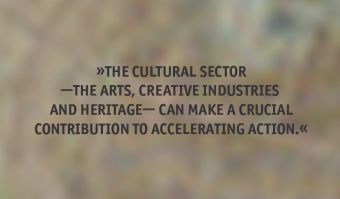
contribution to accelerating action. Culture is vital to national economies, contributing creative skills and innovation, and influencing lifestyles, tastes and consumption. But, most powerfully, art can change hearts and minds and it is intimately connected to place and to community. Artists can move us to reimagine our world and inspire societies to take climate action and contribute their best to the Next Renaissance.
Alison Tickell
Alison Tickell established Julie’s Bicycle in 2007 as a non-profit dedicated to mobilising action on the climate crisis, initially in the music industry and now across the arts internationally. Originally trained as a cellist, Alison worked with jazz improviser and teacher John Stevens, and community activist Dave O’Donnell at Community Music rethinking music education: what it’s for, what it values and who thrives, before setting up Julie’s Bicycle. She has also had many other roles (voluntary and paid).
Alison is an Ashoka Fellow.
Picture © James Allan
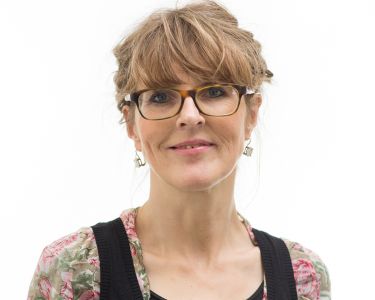
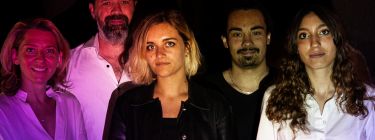
We are all Creative Tech-ers!
Laure Kaltenbach, Chairman and co-founder of CreativTech, curator and scenographer; Faustine Charles, Lydia Meignen, Paris
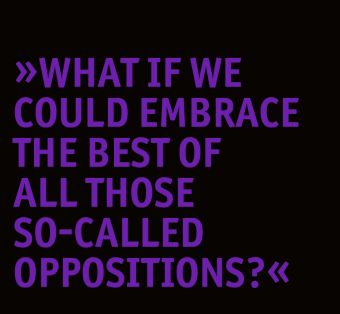
We are all Creative Tech-ers!
Why choose between artists and engineers
Chicken or egg, tea or coffee, maths or literature, music or sport, nuclear or green, left or right brain, passion or reason, artist or engineer? Do we really need to choose in every compartment of our lives? What if we could embrace the best of all those so-called oppositions?
The artist, a figure integrated into our socioeconomic models
The opportunities of the health crisis for Culture?
As in all crises, we realise the extent to which culture plays an essential, central, and apodictic role in expressing itself, through the arts, in entertaining ourselves, promoting values, creating cohesion, in giving meaning to what seems to have none. The current health crisis is no exception to the rule and new forms of creation have multiplied to experience this unprecedented time of collective global confinement. Among the encouraging examples, the creation in Italy of Special Artistic Continuity Units (Usca) by the company il Barbonaggio Teatrale with theatre on delivery—the theatre at home—was conceived in response to the prolonged closure of cultural venues. From now on, it is possible to welcome a plastic work at home, such as
“Tipping Point,” a work by Barthélemy Antoine-Lœff. If you don’t come to Lagardère, Lagardère will come to you. Simple and efficient. Beyond its crucial role for individual and collective mental health, culture is the vector of three living dynamics in our territories: it drives and increases the attractiveness of rural areas, cities and regions; it is the engine of a diversified social cohesion; and finally, it creates economic value. Culture is an economic force that is now on everyone’s lips—those of politicians, institutions, companies in the cultural and creative sectors: 2250 billion euros, or 6.1% of world GDP; 353 billion euros in exports, or 3.4% of total world trade; and 29.5 million jobs, or 1% of the world’s active population. In Europe, culture employs more than 8 million people and represents 4.4% of the territory’s GDP in 20191 (i.e. before the COVID-19 crisis). These are higher revenues than telecommunications or the pharmaceutical industry! With more than 800,000 companies, 3.2% of the companies in the European Union, the cultural sector is also a source of human exchanges: in fact, 40% of inter-European tourists travel for cultural purposes.
Culture is now integrated and considered as an asset in our economic models. However, we still need to shift the focus on the role of artists and their contribution to innovation: social, technical, technological, scientific. Lilian F. Schwartz (born in 1927) was a leading figure of innovative artists thanks to science. She is one of the first artists to join the scientific team of a laboratory and served in Bell Labs in 1968 (known particularly for having worked on the Apollo Program). There she became a pioneer in computer-assisted visual experimentation, with 2-D and 3-D animated videos, a great innovation at the time! Yet, Schwartz is presented as a visual artist and not as a contributor to technical innovations, with her works staged hermitically in events and cultural institutions.
Back to the future
Culture is a combination of different imaginary worlds that we cherish beyond our borders. The creation of Ministries of Culture (Germany in 1955, France in 1959) marked a governance based on knowledge, recognition, and the sharing of values. The first international music festival created by Richard Wagner in Bayreuth, to share culture between nationalities and generations, dates back to 1876. More recently, the European Days of Culture were established in 1991. This is a Europe of culture whose milestones reveal both a proactive political construction and an enlightened renewal of artists and their understanding of societal issues. How should creative dynamics and artists take their place in a world that integrates ecological and epidemic ultimatums? Certainly, artists have and always have had a capacity to imagine, to shift, to reveal, to leave the beaten track, to dream, to scare, to question. Certainly, we need more than ever this capacity to invent and crystallise our aspirations. Certainly, we could be satisfied with a place of the artist reserved for museums, galleries, accursed
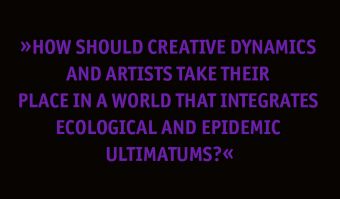
avant-garde, institutional spaces, or the oppositions between the arts from the street and those from the academic training. Of course, our time amalgamates, and everything becomes „art and culture“. Every evening we declare the death of art, and every morning it is reborn. With or without ashes.
One of the characteristics of our time is the capacity of artists to perform, to hybridise, to „hack“ techniques and technologies. An exploration that becomes polysensorial, simply listening to our senses. And it is in the search of the sense, of our senses, that the artist must create a new place and put his talents, his imaginations in the service of new social hybridisations. More and more of us are questioning ourselves, taking a step back. The artistic approach is a powerful one in a world where the link between the real and the virtual, between the physical and the digital spaces, between the material contents and the 0 and the 1 becomes more and more tenuous. The notion of a digital mirror world to ours, the umpteenth desire to live an increased polysensoriality in other spaces, materialises in the metaverse, a new Eden offering countless horizons. Let’s keep in mind the words of J.R.R. Tolkien in order „not to confuse the prisoner’s escape and the deserter’s flight“: embracing virtual worlds is in no way a flight, but a relevant anchoring to reality. To appropriate parallel digital worlds is not an ultra-modern obsession, unconscious of the stakes and dangers; it is, on the contrary, an opportunity to make those digital worlds deeply human and at the service of humans.
Artists are now producing hybrid works and exploring advanced
technologies for offbeat and sublime realisations. They also give impetus to applications that go far beyond the cultural sector. When Martin Cooper, a Motorola engineer recruited in the early 1970s, built a portable radio by trying to reproduce Captain Kirk’s “Communicator“, he invented the cell phone. The list goes on and on of other inventions, imagined by the creators of Star Trek, that have inspired companies and are now part of our daily lives: the “replicators“, ancestors of 3-D printers; the „Universal translator“ in charge of communicating beings and aliens from all galaxies, today revealed in automatic translation software, algorithms and artificial intelligence (AI); and the freehand kit of Lieutenant Uhura, the “tricorder”, which allows the user to detect and scan diseases, present today in almost all Internet of Things and wearable tech, but also giant screens, video calls, tablets, and of course PCs.
Back to the present: do you know Fragile? This installation, created by the Italian multidisciplinary studio, Fuse, explores human and organic life in its works. The installation, with evolving visual effects, is based on an algorithm that collects tweets to predict the level of stress they generate. As social networks are spaces that bring together an important part of humanity, the work gives a vision of the level of anxiety and, by (black) mirror effect, of the well-being of the actors of these networks. Among other fascinating disciplinary crossings, the TakT duo, building on the advances of neuroscience to understand our emotions, has designed an audiovisual work called „Scientific Emotions“ which deciphers our emotions through both artistic and scientific imagery.
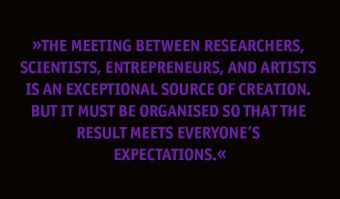
New rules of the game
This context seems to be conducive not only to the reaffirmation of the place of artists in the economic and social ecosystem, but also to the intersectoral spread of talent. The multiplicity of paths, training, decentralised learning, the possibility of combining disciplines and fields of expertise change the rules of the game. In concrete terms, encounters with artists must multiply and go beyond the cultural and creative sectors. The image of the artist as an entertainer, or even as someone who is unfit for scientific and economic rigour, is long gone. This image is not only caricatured but also light years away from the reality of an artist who, like a scientist, relies on the senses, his intuitions to create, invent, draw, compose, repeat, make mistakes, take up again, undo, redo, in a long-term iterative creation cycle. The meeting between researchers, scientists, entrepreneurs, and artists is an exceptional source of creation. But it must be organised so that the result meets everyone’s expectations. The good news? It’s an equation that works every time! On a regional, national, and European scale! Examples are coming from all over the world, at the crossroads of all knowledge: research on biomimicry, which takes nature as a starting point and inspiration, is becoming a reference: from politics to medicine, from the arts to logistics, the behaviour of organic and animal species are rich in lessons and solutions. Bulletproof vests? Born from the observation of the resistance of spider threads! The physical-chemical engineer Kalina Raskin announces that life will endure without us. From now on, she is looking for ways to make different forms of life cohabit within the framework of a responsible innovation that considers the rhythm of nature, and this, thanks to… groups of thinkers from different „worlds”. Inspiring, isn’t it?
Mixing the worlds: a winning solution for the future
Desperately (really) seeking creative co-working
Today, no one questions the crucial role of collaboration in innovation: between brands, between teams of the same company, between teams of companies from different sectors, between generations, between countries, etc. However, the holy grail has not yet been found for an implementation on a European scale that would make it possible to embody these transdisciplinary collaborations on a large scale. We remember the innovative European programs, notably Kaleidoscope (one of the first financial support programs for artistic creation and cooperation, 1996-1998) and Culture 2000 (2000-2006), with disparate effects at European level. How to make collaboration between actors and territories concrete without confusing team-building and innovation?
This European ambition needs a program with a relatively long timeframe so that fertile crossings materialise and that tomorrow, an Italian neuroscience laboratory works with Swedish designers to
create a new banking service, a Dutch dancer gives new foundations to a German algorithm to facilitate inventories in warehouses, a Slovenian AI researcher relies on a French designer to invent a new industrial co-bot, a Portuguese musician virtualises a new Belgian technology to lay the foundations of a humanised call centre, a Luxembourgish quantum physicist makes new discoveries thanks to a Finnish photographer to secure protocols… It is a strong impetus that must be given so that examples do not just multiply but become a Pavlovian reflex for innovation. Will the European Knowledge and Innovation Community (KIC) for the cultural and creative sectors make the magic possible? The stakes are high and concern all stakeholders: companies have concrete innovations for their products or services, explorations but also managerial transformations; research renews its opportunities for opening up, highlighting its skills and contributing to the attractiveness of the scientific field; artists benefit from unprecedented industrial and scientific means to create an ambitious „work-innovation“. Concrete and successful examples of this approach exist. CreativeTech has produced several in France, notably, in the Pays de la Loire region.
Culture is future
Culture au Futur© (Culture is Future) is a transdisciplinary innovation and creation project conceived by CreativeTech for the Pays de la Loire region in France. This original program allows the creation of „innovation-works“ in the framework of workshops bringing together a company, one or more researchers in a scientific field and an artist (or a collective of artists). In other words, it is a question of simultaneously mobilising the cultural, economic and scientific actors of a given territory. The result is startling. The originality lies not only in the method invented by CreativeTech but also in the place of artists in the innovation process: it is indeed the artists who give the initial impulse to the collective work. All industrial sectors, all research fields and all artistic disciplines are concerned. The “innovation-works” already produced reveal the capacity of the trinomials to jointly respond to societal issues (ecology, recycling, over-cycling, acoustic waves, future industry, economic cycles, …) and technical issues (stabilisation of pigments, data restitution, remote control by algorithm or application…).
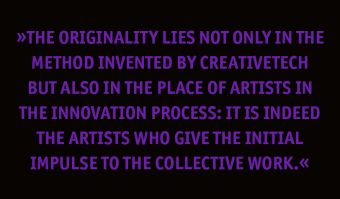
Pascal Denoël, President of the ZeKat Group, who participated in season 1 of Culture au Futur,sums up the experience as follows: „You abolish all boundaries. Everyone must create according to their technological and artistic sensibilities and within a project that has a dimension that goes beyond the company; everyone must remove their own barriers. At this point I see my collaborators differently as a leader, but they see each other differently. People talk to each other more easily and respect each other much more easily. (…) And the result is tangible: the technological innovations that were conceived together are going to be found in our products, to be marketed. And the spectacle is magnificent.“
Europe strikes back
It’s a credo that Europe is starting to put into action thanks to some truly original programs that think big in space and time. This is particularly the case with the audacious S+T+Arts program launched in 2015, where the world of technology brilliantly meets that of artists. Bringing worlds together also means bringing together nationalities and cultures. The Erasmus program embodies this brilliantly: bringing students together and benefiting from the lessons of other countries to enrich their future professional lives. The good news is that Europe is home to 23 million companies, 2 million scientists, and 1.4 million artists. What are we waiting for to make the intersection of disciplines for innovation the European trademark!
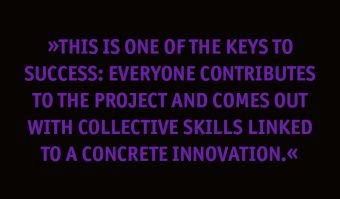
Human first! People at the heart of the transdisciplinary process
Yoga positions: Aligning humans in the centre of our path
The mantra seems „simple“: put in the same space (physical or virtual) a company, a scientist, and an artist. This collective star alignment requires a dedicated environment and a marked methodology to go beyond the often-deceptive concepts of hackathons or lightning exploration projects. It is indeed about combining mind and body, through rituals, a lot of discipline and a lot of intellectual flexibility but not only! Sonia Bergeot, planner for the Colart Fine Arts group of materials, saw the alchemy take place during the workshops of season 1 of Culture au futur: „The manipulation of products with chemists and artists awakens new inspirations for future developments of products or services for the company. That’s where the magic happens.” The credo is that each stakeholder—artist, researcher, company employee and animators-conductors of the “work-innovation”—highlights their own skills, without disguising themselves, in a spirit of curiosity. Indeed, it is a question of giving the best of one’s way of being, thinking, working, and interacting with worlds foreign to yours. This is one of the keys to success: everyone contributes to the project and comes out with collective skills linked to a concrete innovation. A great community of CreativeTechers is born.
The creation of artwork-innovation—“it's alive, alive!”
Within the framework of our interventions, we work on projects at the crossroads of innovation and creation. For example, a company making clothes for professionals had the ambition to think about tomorrow’s work clothes, by collecting data on individuals, to limit difficulties at work. A visual artist poetically re-examined the materials in order to illustrate the dynamics of the company immersed in issues of health and well-being at work. Cross-fertilisation also led us to the hacking of a Smart Guitar with the aim of completely reinventing the scenography of a show and the way in which one can remotely control the instruments on stage thanks to a virtual reality headset and a gyroscopic application. Or a textile manufacturer of more than 200 wished to re-examine the life cycle of its materials and, thanks to the crossed views of researchers in acoustics with that of an artist specialized in the fold, the company was able to upcycle these dormant stocks. The latter were transformed into powerful soundproofing sheets! What a smart collaboration…Ultimately, applying the CreativeTech’s methodology empirically means creating hybrid project methods according to the realities of the actors involved, guided by the same desire: to create a work and find an operational solution to a business problem in a “win-win” and transgenerational logic. Europe is the new playground, and with its protean resources, the possibilities are endless. Finally, some good news!
Join the CreativeTechers’ generation
The winning equation—companies x scientists x method artists x humans—is on its way to be disseminated in Europe. Our famous equation is endowed in—take note, exhibitors!—a proven method and people ready to take up challenges.
Approximately 4.2 million km2, 27 countries, nearly 90 territories with their own systems of governance, about 400 cities with more than 100,000 inhabitants, soon to be 448 million inhabitants, with Ode to Joy as its anthem—does this sound familiar? What if the result of this winning equation made it possible to create a European „overview effect“ (like the planetary overview effect described by the astronauts) that would sublimate all our creative resources in order to deploy a collective and enthusiastic vision of the future in the territories, regions, länders, provinces, and departments of all of Europe. „Arts and Crafts“ reinvented in the 21st century: easy, right?
“The history of science is not only the history of the constitution and proliferation of disciplines, but at the same time the history of the rupture of disciplinary borders, of the encroachment of a problem of one discipline on another, of the circulation of concepts, of the formation of hybrid disciplines that will end up becoming autonomous; finally, it is also the history of the formation of complexes in which different disciplines will aggregate by agglutinating themselves. In other words, if the official history of science is that of disciplinarity, another linked and inseparable history is that of inter-trans-poly-disciplinarity.” Edgar Morin2
References
1 Marc Lhermitte, Hugo Alvarez, EY, January 2021. https://www.ey.com/fr_fr/government-publi-sector/panorama-europeen-des-industries-culturelles-et-creatives-editio.
2 Edgar Morin, “La méthode”, 1981.
CreativeTech
Being: together! Born 2017, CreativeTech is a cultural engineering agency that orchestrates the meeting of artists, scientists, entrepeneurs to generate go-to-market innovations and exhibitions, both in digital and physical locations. This synergy of points of view, experiences and expertise embodies the current hybridization of profiles in all the industries. This Bigbang delivers supernova.tive makers and thinkers and constitutes the DNA of CreativeTech methodology.
Inspiring the future! CreativeTech also strives to think optimistically about the future, always integrating a responsible and conscious approach to social and environmental issues in the different territories. The aim: developing operational innovation for companies as well as institutions toward contemporary questions, such as living in the age of the blockchain and metaverse, hacking Time and Space, tapping into neuroscience to decipher the power of our emotions… to inspire all of us.
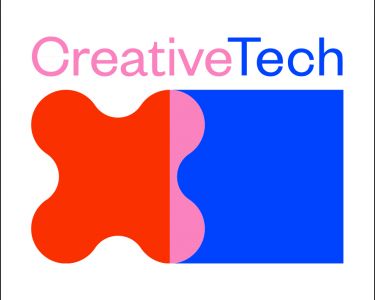

The future belongs to the creative
Hamburg Kreativ Gesellschaft

The future belongs to the creative
How companies use the potential of the creative industries to stay innovative
Tesla is not a car manufacturer. Tesla is a software company that also makes cars. The car is one product of many, limits are not set. Tesla founder Elon Musk always thinks in terms of opportunities and possibilities, but never in terms of traditions. And that’s new. These are new realities of life that now pose major challenges for numerous companies, especially when it comes to developing innovations. Because tomorrow’s innovations are at odds with today’s industries. In this piece Hamburg Kreativ Gesellschaft mbH shows how looking into the future of content and creative industries is a tool to improve innovation today—across all industries.
The automotive industry is currently experiencing new realities very accutely, especially as it is in the midst of the biggest transformation process in its history. If we leave aside the most obvious challenge—namely the technical component—from the combustion engine to the emission-free automobile, we see a development whose dimensions should not be underestimated: User behaviour is changing dramatically. Not everyone wants their own car and car-sharing is becoming more and more common. In addition, there is a growing environmental awareness, but also social areas of conflict (for example, available and affordable housing) are displacing the supposed self-evidence of owning a car.
Picture above: Welcome at Play Day Final, Copyright by Laura Müller
Picture left: Demo Prototype, Copyright by Laura Müller
The image of the future
The new mobility—especially in large cities—is creating an acute need for innovation in the industry far beyond the ecological-technological sphere. Thus, data- and content-based business models are becoming a central component of a sustainable business model. For the automotive industry (as for many other industries), it will also be a matter of crossing previous industry boundaries and working in an interdisciplinary manner in order to remain capable of innovation. Above all, however, companies will have to deal more and more intensively with the future. We often still cling to the idea that we can’t determine the future, but that it will be determined. But that may prove to be a mistake. Instead, we will have to create tools and methods to really look ahead. Only in this way will the picture emerge toward which we must work.
In 2019, nextMedia.Hamburg and the Cross Innovation Hub (part of Hamburg Kreativ Gesellschaft mbH) developed Content Foresight, a unique, Europe-wide tool for bringing together different perspectives, different know-how, different inspirations, and also very different creative approaches in a media- and technology-diffuse world. Content Foresight has since proven to be a highly effective method for making reliable predictions for the content industry based on creative input and interdisciplinary collaboration with other industries. Just one example: If autonomous driving becomes established in the medium term, mobility providers in particular will have to become much more involved in other business areas than before. Because when the car drives itself, drivers will have time and space for new forms of occupation, new forms of media use. This, in turn, requires creative and content-related input, i.e., content! And that promises enormous potential for creative and media professionals.
Content Foresight promotes creative innovation work
The Content Foresight innovation program we developed is a tool for testing new applications and future business areas for the content and media industry. Content Foresight is based on the research-proven methods of Strategic Foresight and was adapted and further developed by us for the content industry. Beyond the productive interdisciplinary setting, Content Foresight thrives on impulses, ways of thinking and specific skills of external creative professionals who are included in the innovation process. These professionals come from the different submarkets of the creative industries to form a so-called „pool of creatives“. As part of the project, they are not only paid for their contributions, but also meet the participating companies at eye level and can build a new network. Applicants so far have been people from the various submarkets of the creative industries, with a focus on different digital competencies, i.e. software development, PC games, interaction/UX design, sound, virtual and augmented reality and storytelling.
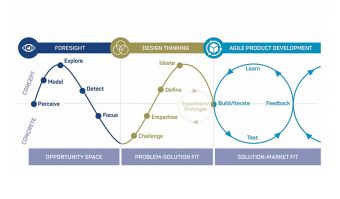
The new renaissance of the creative
The „New Renaissance“ that is emerging now, at the beginning of the 21st century, will have to leave behind the purely growth-oriented, resource-consuming innovations and thus bring about socially desirable changes. The term Renaissance was chosen deliberately because the „old“ Renaissance, i.e. the period between the 14th and 16th centuries, led to a boost in innovation in various areas; it was the time when technology and art, science and creativity merged. We want to build on this—especially in times of the COVID-19 pandemic—in order to contribute to overcoming the crises of our time. Because it is a sector that we hold in high esteem which is becoming the driving force behind this movement: the creative industries. It seems to be the sustainable winner in the merging of all areas of our lives. It is characteristic of the new renaissance that problems and crises can be solved more and more effectively across all areas and sectors. What was once separate, the creative person is able to connect with bridges and lead to innovative solutions. The creative industries are now an innovation-driving sector of the economy that is successfully leading other economic players into the new renaissance.
Picture left: Foresight Process / Copyright: Rohrbeck Heger GmbH
In recent years, the content-producing players in the creative industries—the publishing, media and music sectors, and of course journalism—have been the first sectors to digitise and transform themselves and they continue to do so. This is because the traditional media companies are facing a permanent change in terms of the behaviour and demands of the users of their products and services. Subscriptions are becoming memberships, content providers are becoming curators, and monothematic offerings are becoming lifeworlds and services that must be able to be mapped seamlessly on all platforms. As a result, data-driven business models are moving further into the foreground. Diversified business models must be found to suit the sovereignty, flexibility, and individuality of these users. With the credo of „meeting users where they are“, the industry has had a self-imposed target since the 2010s and continues to be dependent on technology and data, and thus on monopoly-like infrastructure providers, such as platforms, software and hardware providers. One also observes within the content industry an increasing merger of different providers into cooperations, alliances or mergers—and with it an increasing willingness to innovate, indeed an innovative power.
In other words, the content industry has the best prerequisites for the new renaissance.
Picture right: Status Quo, Copyright by Laura Müller

Looking to the future promotes the innovative power of today
In our view, Strategic Foresight is therefore the most suitable method for bringing together areas that are supposedly alien to one another to exchange ideas and find concrete solutions to their current and future challenges. After all, looking into the future promotes innovation today. However, companies still too often face major hurdles in perceiving and exploiting this potential. But simply dealing with a time horizon of five years is still unusual in companies. In order to better cope with the approaching, rapid changes and not only remain capable of acting, but also to be able to shape the future, even more courage and willingness to take risks will be required in the future.
This willingness also includes cooperation across industry and company boundaries. Most industries and management strategies still seem to be unfamiliar with open and cross-innovation processes. Yet the increasing complexity of our world is due not least to the convergence of markets and industries. So while classic competitive thinking can make long-term innovation even more difficult, it is often neutral and supra-organisational approaches that can create new spaces of opportunity and change mindsets. And above all, the involvement of the creative industries creates additional potential. Their ways of thinking and working not only provide new impetus for the innovation process itself, but are also becoming indispensable in view of the need to shape a new, sustainable, equitable future.
Picture below: Michail Paweletz reads 2034, Copyright: Laura Müller
For the practical application of content foresight, we rely on the following approaches:
1. With a cross-innovation approach, we create a setting that is considered to be particularly conducive to innovation and can thus bring two different sectors into innovation work in a targeted manner, in which we work in a user- and solution-oriented manner with the help of methodologically sound processes.
2. The focus is on methods of strategic foresight, which not only look at the development of possible futures, but also specifically enable the identification of so-called opportunity spaces and thus recommendations for action to successfully anticipate them.
3. In the subsequent design thinking process, concrete prototypes are developed alongside the joint visions. In addition, we rely on special impulses in these processes through targeted collaboration with actors from the creative industries.
4. As a public provider, we also act as a neutral player in this process and create trust among the companies involved and, where applicable, among competing companies.
With this setting, in a format that is unique in Europe, we are not only creating an experimental area for concrete approaches to current and future challenges, but also new impulses and foundations for the sustainable innovative capacity of the participating players.

So what do the possible futures look like when actors from the content industry work together with mobility experts? Where are the opportunity spaces? Content Foresight – Mobility by nextMedia.Hamburg and the Cross Innovation Hub produced the following triad of innovations:
Business ideas using the example of the content & mobility interface
I.
2024. For a time horizon of five years, the Hamburger Morgenpost and Schwan Communications have developed a tangible solution for linking content and mobility offers that can already be implemented with current technologies. The prototype Digital Guided Tour /HAM offers users multimedia content (video, audio, text) that functions in a wide variety of means of transportation, is coupled with them, and whose playout is adapted to the means of transportation. In this way, it not only offers content providers new distribution channels, but also creates incentives for the use of public and/or climate-friendly means of transport in the city—from e-scooters to sharing offers and public transport. This applies not only to local residents, but also to the more than seven million tourists who visit the Hanseatic city every year, thanks to the integration of tourist attractions and historical content.
II.
2029. The project team of MaibornWolff and pilot Hamburg planned the next step: With S.T.E.P—the Seamless Travel Experience Platform—mobility and entertainment/information are individually tailored to the user. Instead of having to actively choose from countless options how to get from A to B and which content can be consumed on the way, a digital twin creates situationally optimal decision bases for seamless travel planning. The blockchain-based application already developed promises all-in-one processing. In a planning horizon of about five to 10 years, app chaos on smartphones will then be as much a thing of the past as login madness. Through a public-private ownership model, in which the public sector acts as a regulator, a critical mass of services and users* can be aggregated, which can fully keep an eye on the optimisation of passenger transport, independent of the economic success of individual providers.
III.
2034. What’s next? How do we envision mobility and content when blockchain technologies and AI-supported systems have long since become part of our everyday lives and our data precedes our decisions? Representatives from NDR, Axel Springer, HOCHBAHN, IAV, ITS Hamburg 2021 and Wunder Mobility give us an impression of this in their concept of experiential mobility. In the sense of a pre-prototype, the team developed a vision of mobility in a time horizon of about 15 years, which considers social (e.g. environmental protection, education), political (e.g. data sovereignty), technological (e.g. autonomous driving, artificial intelligence as technology serving people, digital identity) and individual aspects (e.g. consumption, convenience) in equal measure and integrates them into product and service scenarios.
The vision, spoken by ARD news anchor Michail Paweletz, is publicly available here.
Open even to unfamiliar input
So… You can’t do it without looking into the future. But… Everyone looks at the future differently. To find the best solution together, it is crucial to organise an exchange—and to learn from each other. This is the only way to create innovations.
If you want to be innovative tomorrow, you have to be open today, even for unusual input—and above all for new content!
Quotes from company representatives:
Dr. Johanna Leuschen, Head of NDR Audio Lab (Norddeutscher Rundfunk)
„We believe that in the future we will always get the content that is best suited to our mood, in the current mobility situation, in the time available. The keyword here is personalisation. The user focus is and will remain essential. For journalism, AI could be useful in an assisting role: Tasks that do not necessarily require creativity (weather, election or sports results) could be taken over by algorithms. Then journalists could devote themselves entirely to creative and research-intensive topics. And we assume that companies in general, not just content providers, should look at an audio and voice strategy and tailor their offerings for a voice-driven world in the long term. Discoverability is going to be a big challenge going forward.“
Nicolas Meibohm, Head of Connected Car (Axel Springer SE)
„We often still cling to the idea that we can’t determine the future, it will be determined. But that is exactly the mistake. So now, once we really look ahead, we get a picture we can work toward. This program has set a benchmark and proven that interdisciplinary collaboration really makes sense.“
Hendrik Menz, ehemals Director Business Development (pilot Screentime GmbH)
„It takes a wide range of relevant expertise and value-added fields to absorb the necessary complexity of a holistic approach.“
Dr.Nina Klaß
Dr. Nina Klaß is an expert in content and tech innovation. She leads nextMedia.Hamburg (part of Hamburg Kreativ Gesellschaft mbH) where she developed and executed a range of highly recognized innovation programs such as the Content Foresight project. Previously, she was head of digital product marketing & sales management at SPIEGEL Group. She is active as funding committee member, jury and advisor of innovation programs worldwide.
Picture © Oliver Reetz
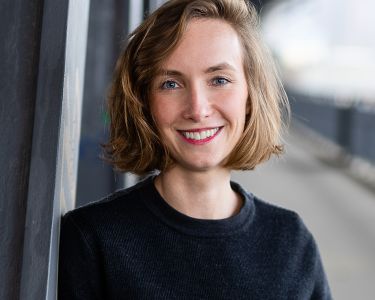
Egbert Rühl
Egbert Rühl has been active as a cultural and arts facilitator his whole life – in many different genres and functions. He is the managing director of the Hamburg Kreativ Gesellschaft. In this role, he is responsible for strategy and tactics, guidance and moderation, budget compliance, and contact with politics and administration.
Picture © Oliver Reetz

Marc Eppler
Marc Eppler is responsible for nextMedia.Hamburg’s partner management and he operates programs such as Content Foresight. Previously, he worked at the Franco-German culture channel ARTE in Strasbourg.
Picture © Oliver Reetz
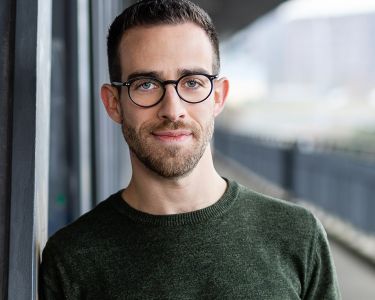
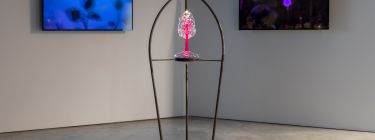
Stranger To The Trees
Artist in Residence at the Faculty of Maths and Physical Sciences, University College London & Fellow of the Royal Society of Arts
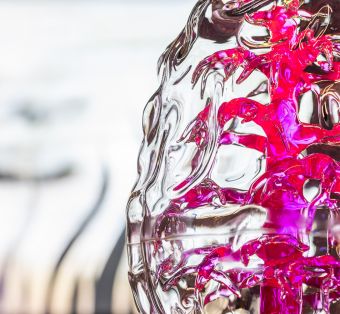
STranger to the trees
Hybrid art uncovering a new materiality in our world, for crisis or awakening…
The Green Transition of our society is urgent and will drive the renewal of cities and economy alike, as we overcome the Covid-19 pandemic. However, to move beyond our current relationship with what is casually called “the environment”, we must in fact reconfigure the understanding of humankind’s influence on the planet.
Stranger To The Trees (STTT) is a transdisciplinary art-led project that sheds light through a hybrid artistic form on the invisible but harsh reality of how microplastics are changing the materiality of the world. The work steps outside of the human perspective by focussing on the possibility of coexistence between microplastics and trees. In so doing, the work addresses a fundamental necessity—that of moving beyond a human-centric view to achieve a more-than-human understanding of the echoes of human activity.
STTT is a multimedia, interactive installation that combines sound, sculpture and video, alongside a scientific publication (Austen, 2022). A combination of these forms of output sheds light conceptually, factually and emotionally on the possibilities and meanings of microplastics and birch trees coexisting in the time of the climate crisis.
Microplastics are a ubiquitous and irrevocable anthropogenic new material dispersed throughout the environment reaching the furthest and wildest crannies of the planet. Particles of plastic have been found in the clouds, on top of the tallest mountains and in the deepest ocean trenches. This artificial material represents the uncompromising impact of human activity on the planet and has already been observed to be an evolutionary prompt for microorganisms. Furthermore, microplastics’ presence is an embodiment of our addiction to the extraction of fossil fuels, or as they should properly be named, long carbon reserves.
We cannot call back these tiny fractionations of humanity’s exploitative industrial legacy. They persist even beyond our reaches, changing the materiality of the world and the entities within it, even ourselves. What we can do is to reconfigure our understanding of the consequences of this undeniable reality. The artwork Stranger to the Trees addresses this issue through the lens of coexistence. The work realises in hybrid artistic form the new materiality of the entanglement of forests and plastic pollution.
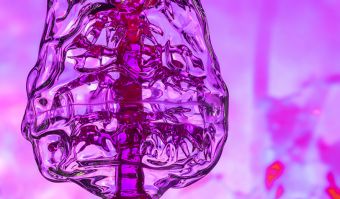
The project was driven by a motivation to understand the stark reality of microplastic pollution from a more-than-human perspective. Central to the concept is the fact that plastic pollution is, like forests, itself a carbon sink. In the context of fossil fuel extraction and the carbon cycle, the question arises of whether microplastic interaction with trees might, beyond the instinctive horror of artifice pervading nature, carry another meaning. The research for the project, which is still ongoing in the form of a long-term experiment, mixes artistic and scientific methods to explore how birch, a pioneer tree species, and microplastic particles interact.
Stranger to the Trees successfully melds DIY and traditional scientific research with artistic research and production. The diverse outputs, each impactful in its own way, together provide access to a new understanding of what we perceive as nature. The project showcases a modality by which to develop the aesthetic, cognitive and embodied knowledge needed in order to move towards a more just, resilient future in which humans cooperate with those entities with which we share the planet.
References
Austen, K, Maclean, J, Balanzategui, D and Hölker, F, “Microplastic inclusion in birch tree roots”, Science of the Total Environment, 808 (2022) 152085 https://doi.org/10.1016/j.scitotenv.2021.152085
More info: https://www.katausten.com/portfolio/stranger-to-the-trees/
Other partners involved (think of artists/ producers/ industry/ science collaborators): STTT is realised within the framework of the European Media Art Platforms EMARE program at WRO Art Center with support of the Creative Europe Culture Programme of the European Union
All Photos: Copyright by Andreas Baudisch
Kat Austen
Kat Austen is a person. In her artistic practice, she focusses on environ-mental issues. She melds disciplines and media, creating sculptural and new media installations, performances and participatory work. Austen’s practice is underpinned by extensive research and theory, and driven by a motivation to explore how to move towards a more socially and environmentally just future. Working from her studio in Berlin, Austen is currently Artist in Residence at the Faculty of Maths and Physical Sciences, University College London, Senior Teaching Fellow at UCL Arts and Sciences and Associate Artist Fellow at Institute for Advanced Sustainability Studies, Potsdam. Her studio hosts two Scientists in Residence through the STUDIOTOPIA programme hosted by Ars Electronica. She is a Fellow of the Royal Society of Arts. Austen was Artist in the Arctic 2017 for Friends of Scott Polar Research Institute (University of Cambridge) for her project The Matter of the Soul. In 2018 Austen was selected as inaugural Cultural Fellow in Art and Science at the Cultural Institute, University of Leeds for the same project. Austen has been awarded residencies internationally, including EMAP / EMARE Artist in Residence at WRO Art Center, AiR at NYU Shanghai, ArtOxygen Mumbai and LAStheatre.
Picture: © Andreas Baudisch
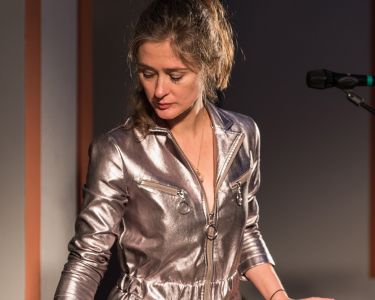
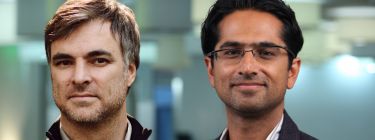
Beyond Instrumentalism
Director of Creative Industries Policy & Evidence Centre at Nesta & Fellow on Art and Society, Metcalf Foundation
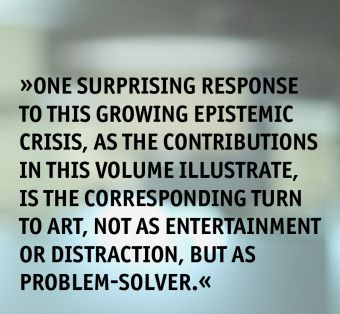
Beyond Instrumentalism: The Aestheticisation of the World
Climate change? Global pandemic? Collapsing biodiversity? Distressed migration? Spiralling inequality? Cutting across many of the urgencies facing humanity is a growing epistemic crisis, a widening gap between our knowledge paradigm and the problems of our day. One surprising response to this growing epistemic crisis, as the contributions in this volume illustrate, is the corresponding turn to art, not as entertainment or distraction, but as problem-solver. While this appears to be largely instinctive—a collective intuition ungrounded by conceptual or methodological clarity—it deserves investigation.
The Crisis of Knowing in the Age of Complexity
How did our problems and our problem-solving get so disconnected? During its rise to prominence, Western, Enlightenment rationality systematically divested itself of subjectivity in order to see the world objectively. Human values, perspectives, and beliefs were dismissed in pursuit of irrefutable facts. The complicated world has become the complex world and with a knowledge paradigm built for the former, we find ourselves, to use a recent metaphor, trying to play three-dimensional chess on a two-dimensional board. Our missing dimension often goes by the name ‘the normative’, indicating elements of identity, meaning, purpose, belief, senses of time and place, and the underlying ontologies shaping our conceptions of the world and ourselves within it. We see this in the declining capacities of our R&D paradigm, privileging science and technology and rendering contributions from the arts, humanities and social sciences illegitimate. The R&D paradigm is built for the problems of two-dimensional chess, but the crises that define our age cannot be resolved in two dimensions alone. Can knowledge creation which enriches our understanding of, and engagement with, these irreducible uncertainties, be of greater societal value in the Anthropocene?1
Art as Magic Bullet
Complexity features an entanglement of normative or human dimensions shaping the problems we are hoping to solve within a paradigm built to ignore those exact dimensions—leading much of the early 21st century on something of a fool’s errand. Yet why the turn to art? Might it weave human values, perspectives, beliefs, and activities back into how we make sense of the world, thereby allowing us to navigate—and manage—our normative entanglements more effectively? Is it, in other words, a means of shifting from the complicated to the complex by adding a third dimension to our chessboard?
From Plato’s suspicion of poets, to church and state controlling art’s expressive range, or Soviet Socialism’s faith in artists as “engineers of the human soul”, and climate activist Bill McKibben crying out “what the warming world needs now is art, sweet art,”2 the idea that art shapes worlds transcends history and ideology. These perspectives share neither politics, epistemology, nor cosmology. Where art happens, faith in its world-making power grows. We turn to art to shape our societies based on a tacit recognition of how art has shaped us, revealing both the durability and vulnerability of art’s relationship to social impact,3 from “did do for me” to “will do for others.” Herein lies the risk of instrumentalising art; often, our enthusiasm for art finds us trying to replicate effects rather than processes. In trying to replicate what art does rather than how art works we jeopardise the means by which art engages life in aesthetic terms, often disenchanting the very power for which its help was sought in the first place. These dichotomies—effects vs processes; what art does vs how art works—are not meant to dim our hopes to apply art to social challenges, but to distinguish between art as a descriptive capacity versus an epistemic capacity. If art is to expand our proverbial chessboard by shifting how we know the world beyond two-dimensional Western objectivity, it must recognise an often invisible fork in the road. Down one path, art forms a tool to serve our two-dimensional, complicated world; down the other, something potentially more transformative awaits. The latter invites the aestheticisation of the world, a reopening of that once-maligned plane of engagement we tried to close over the course of the Enlightenment.
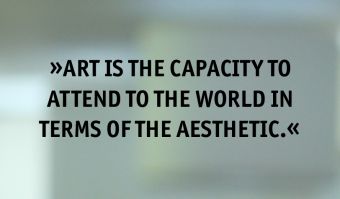
Art as Method
This growing intuition that art offers unrealised capacity to contribute to our growing epistemic crisis deserves enthusiasm. Coordinating the energy and reach of our cultural sectors while bringing them into more applied relationships to societal challenges could prove transformative. Yet such a vision implies an art-society relationship that is necessarily paradoxical—applied yet not instrumentalised, enfranchised yet not autonomous. One approach to this paradox is through a relationship between art and R&D. Historically, these fields dislike each other; art is too impulsive for R&D’s ‘systematic’ approach to knowledge creation, and R&D too reductive to admit the imaginative range of arts practices.4 Yet as art faces a destiny where it is more applied and accountable to its larger impacts, and R&D struggles with the normative dimensions of contemporary challenges, they may not be such odd bedfellows as they seem.
In terms of its value proposition, we often say art is a way of ‘seeing differently’, yet without specifying how, we jeopardise the capacity, while yielding little methodological clarity to contexts of application. Typically, art is considered a power of expression, the sounds, imagery, words, and movements it makes, often leading to its hasty use as a tool for making statements. Yet within this power of expression lies an equally important power of attention. Art is the capacity to attend to the world in terms of the aesthetic; perhaps more than its expressive power, it is perceiving via creative practice that generates such unique value. Consider this within the recursive relationship between mind and world, where mentality produces society, and society produces mentality. Such a dynamic is built for getting stuck. Agency, inspiration, reflexivity and creativity are constrained by design, and design is constrained by agency. Art as a power of attention, a means to engage the world less hampered by this recursive dynamic, offers a unique value that might make the arts vital to innovation. Rendering this explicit articulates a value proposition we can use to operationalise art in service of our worlds while protecting it from being reduced to a charismatic mouthpiece—that ‘power of expression’ alone.
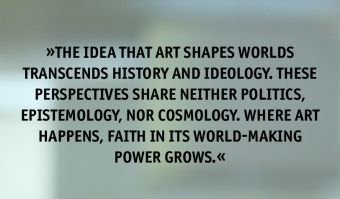
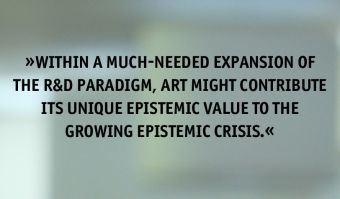
Framing problems in terms of aesthetics is essential to effective applications of arts practices. How do we spot the arts-shaped holes in our world? Here we begin to shape that third dimension on our chess board. Often, we equate the normative with matters of taste and opinion, luring us into thinking that information, data, facts and reason might inspire the reflexivity societal problems like climate change, pandemics, and social and economic justice require. As is far too abundantly evident, divisive dialogue and increasing polarisation are the results of this misconception. Fostering reflexivity, agency, and change at the normative level—that is, navigating that third dimension of our chessboard—requires fashioning carefully constructed passageways that lead from one world to another. Consider how many of us are eager to depart toxic capitalism. Bringing such hope into an applied and accountable relationship with society requires careful consideration of method and evaluation. Clearer problem statements enable more specific questions of artistic method—e.g. what processes engage the problem? And how will stakeholders be involved? In terms of evaluation, words like ‘data’ and ‘assessment’ sound threatening to artists. With clear problem statements and corresponding methods established by the artistic process, can we reconcile the accountabilities of others with our own? In other words, what value does the artistic process seek to produce? Where was this contribution realised or not? What data do we need in order to know? And what processes will be used to interpret and integrate that data in decision-making? This more empowered relationship to assessment allows applied artistic processes to serve more accountable roles in society without trying to prove themselves on foreign terms.
Policy for Playing Three-dimensional Chess
Our core suggestion is that within a much-needed expansion of the R&D paradigm, art might contribute its unique epistemic value to the growing epistemic crisis.
The starting point is to reflect the arts’ distinctive contribution to R&D in the international bible for R&D policymakers, the Organisation for Economic Cooperation and Development’s Frascati Manual: Guidelines for Collecting and Reporting Data on Research and Experimental Development. Now in its seventh edition, the Manual is used by policymakers, statisticians, academics, and others, to help standardise the data collection guidelines and classifications for compiling R&D statistics. In successive revisions, the Frascati Manual has evolved to recognise arts R&D, but it has done so by shoehorning art into scientific understandings rather than extending its own definitions and parameters, e.g., referring to “observable facts” and “knowledge of the underlying foundations of phenomena” not to behaviours, and to “systematic work… directed to producing new products or processes” not to human experiences. Elsewhere in the Manual it is made clear that R&D must aim to resolve scientific and technological uncertainty. It is of fundamental importance that the Frascati Manual and the R&D definitions within it are made fit for purpose for the complexity economy.5
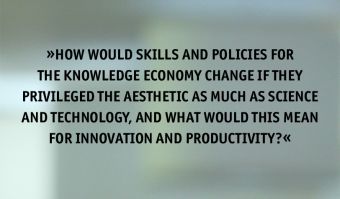
National statisticians in turn must adapt their measurement activities to measure R&D so defined.6 The basics of an approach are already in place with the OECD’s Fields of Research and Development (FORD) classification. Statisticians can use this classification in their R&D surveys to measure R&D expenditure and personnel by fields of enquiry—in other words, broad knowledge domains including the arts–based on the content of the R&D subject matter. Survey returns on R&D spending by FORD are only as good as the accounting data that organisations collect, however, so national statistical institutes need to engage with businesses, public bodies and charities to ensure they too are adapting their R&D measurement systems accordingly.
Armed with more inclusive definitions and metrics, governments can then ensure their R&D strategies, subsidies and tax incentives are fit for purpose too. They can fashion interventions that are designed to fully avail society of the R&D potential of the arts. What, for example, would the missions’ turn in innovation policy look like if artists participated in the setting of grand challenges, foresight exercises, policy design and planning? How would skills and policies for the knowledge economy change if they privileged the aesthetic as much as science and technology, and what would this mean for innovation and productivity? If the qualifying expenditures for R&D tax reliefs were widened to embrace arts R&D, while the arts learned to structure inquiry towards compelling data production, what new interdisciplinary business solutions to society’s problems might we see?
Sources
1 David Maggs, Art and the World After This. Metcalf Foundation, June, 2021.
https://metcalffoundation.com/publication/art-and-the-world-after-this/
2 Bill McKibben. “What the warming world needs now is art, sweet art,” Grist Magazine. April 2005. http://grist.org/article/mckibben-imagine/
3 David Maggs and John Robinson. Sustainability in an Imaginary World: Art and the Question of Agency. Routledge, New York, 2020. See, in particular, chapters 7 & 8.
4 Hasan Bakhshi, Alan Freeman and Radhika Desai. “Not Rocket Science: A Roadmap for Arts and Cultural R&D,” MPRA Paper 52710, University Library of Munich, Germany, revised 01 Jan 2010.
https://ideas.repec.org/p/pra/mprapa/52710.html
5 Hasan Bakhshi and Elizabeth Lomas. “Defining R&D for the Creative Industries,” Nesta/AHRC/UCL, 2017. https://ahrc.ukri.org/documents/project-reports-and-reviews/policy-briefing-digital-r-d/
6 Hasan Bakhshi, Jonathan Breckon and Ruth Puttick.”Understanding R&D in the arts, humanities and social sciences,” Journal of the British Academy, volume 9.
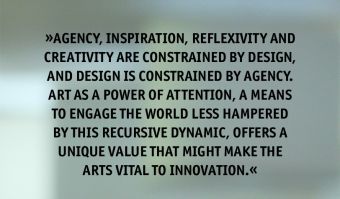
Hasan Bakhshi
Hasan is Director of the AHRC-funded Creative Industries Policy and Evidence Centre, a Nesta-led, AHRC-funded research consortium of ten universities, charged with improving the evidence base for policies to support the UK’s creative industries. Prior to Nesta, Hasan worked as Executive Director at Lehman Brothers, as Deputy Chief Economist at the Foreign and Commonwealth Office and as an economist at the Bank of England. He has published widely in academic journals and policy publications on topics ranging from technological progress and economic growth to the economics of the creative and cultural sector. He is also Adjunct Professor of Creative Industries at the Queensland University of Technology, has an honorary Doctorate from the University of Brighton for his work on economic policy for the creative industries, and in the 2015 New Year’s Honours was awarded an MBE for services to the creative industries. Hasan is a member of the government’s Creative Industries Council, the Department for Digital, Culture, Media and Sport’s Science Advisory Council and Advisory Board for its Culture and Heritage Capital Framework. In 2017, he was elected to sit on the Royal Economic Society Council.
Picture © NESTA
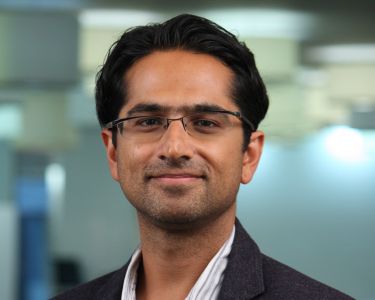
David Maggs
David Maggs carries on an active career as an interdisciplinary artist and researcher focused on arts, climate change, and sustainability. He is the founder and pianist for Dark by Five, has written works for the stage, and collaborated on large augmented reality and virtual reality projects (see Mummer’s Journey). David is the artistic director of the rural Canadian interarts organization Gros Morne Summer Music, and founder and co-director of the Graham Academy, a youth training academy founded in honour of his teacher and mentor, Dr. Gary Graham. He initiated and coproduced the CBC doc channel film The Country, exploring the Canadian government’s handling of indigenous identity in Newfoundland. As a fellow at the University of Toronto’s Munk School for Global Affairs, David co-authored Sustainability in an Imaginary World (Routledge Press, 2020) with mentor and longtime collaborator John Robinson. He is former senior fellow at the Institute for Advanced Studies in Sustainability in Potsdam, Germany, where he led work on culture and climate change. Currently he is the inaugural Innovation Fellow in residence at the Metcalf Foundation where he will explore the role of art in society, with particular focus on innovation, climate change, and cultural policy.
Picture © Grady Mitchell
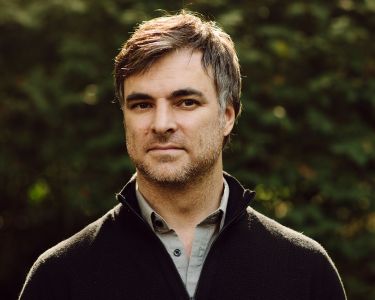
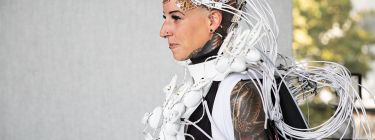
Innovation Through Universitas
Vice Rectorate for Innovation & Researchers at Johannes Kepler Universität, Linz
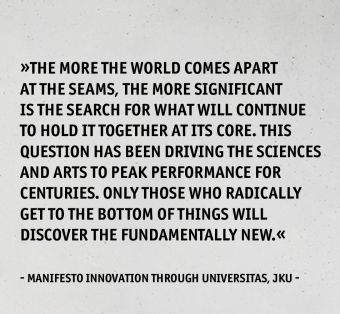
Innovation Through Universitas
The complexity and urgency of current conflict areas poses major challenges for us as a society. Digital and environmental changes are confronting us with a range of unknowns, fundamentally re-sorting our world, and doing so at an enormous speed. Automation and artificial intelligence are permeating the entire economic system, raising fundamental questions, fundamentally changing our everyday lives, and redefining human work. The consequences of global warming, from hurricanes and floods to glacier melt, are pervasive, devastating, and express the need for rapid action. The European Commission’s current work program (2021) not only puts „twin green and digital transitions“ at the top of the political agenda, but also emphasises the close intertwining of green and digital transformation. In this context, it is more important than ever to focus on their interdependencies. The Covid-19 pandemic recently showed how interdependent and interrelated everything is and how highly interconnected our world is. In a short period of time, the virus held the entire world in thrall, had an impact on all areas of our society and required cooperation across borders, institutions and disciplines.
The complexity of these challenges and the multidimensionality of networked systems require the dovetailing of different working methods, perspectives and approaches from science, business, politics, society and art. Only by entering into these synergies beyond one’s own institution, with other scientific disciplines and the integration of different actors, can novel and sustainable solutions be found. This results in a systemic change on all levels of our society. The relevance, potentials and possible practices will be elaborated in this paper using the example of higher education and the re-interweaving of art and science.
While art and science were once closely interwoven and mutually stimulating sources for the creation of something entirely new, with the end of the Renaissance they were steered in separate directions. In order to cope with the ever-increasing wealth of knowledge, the disciplines became detached from one another, leading to a high degree of specialisation and the fragmentation of knowledge.
This liaison between art and science needs to be re-established and strengthened in light of the need for innovative solutions and pressing societal and social issues. The pursuit of new knowledge and the search for solutions in the unknown have always been the driver and motor of both science and the arts.
„The analogical spirit is not only a matter of art, but also of science. May the criteria be different, artistic and scientific creativity have this in common, that it is about discovering, uncovering, endowing, or visualizing connections.“ (Gabriel 2017, p. 194)
Creative thinking, which in science as in art has led to new insights and discoveries is, as Gottfried Gabriel states, a unifying element. This makes it possible to recognise connections and to combine the familiar in new ways. As some well-known examples from the history of science show, it was often a creative idea that led to the formation of a new hypothesis, the subsequent verification of which brought the long-awaited solution to a problem. Expertise and methods for testing the hypothesis are essential. However, discovering, inventing and finding something truly new also requires creativity, which makes it possible to lead in a detached way beyond the limits of the possible.
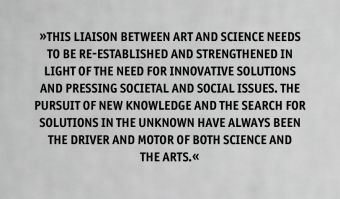
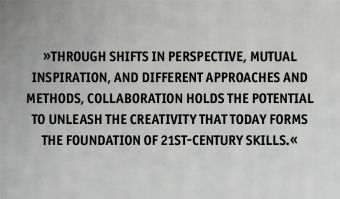
Alexander von Humboldt’s educational ideal and ideas about the university („universitas litterarum“ = „community of the sciences“) are based on holistic education in the arts and sciences and are becoming increasingly important due to current developments. Through their inherent creativity, imagination as well as execution and testing of new ideas, art and science are connected more than is generally assumed. Both are accustomed to navigating through uncharted terrain, do not shy away from complex problems, and, by exploring and creating the radically new, are the source and impetus of innovation in our society. Through shifts in perspective, mutual inspiration, and different approaches and methods, collaboration holds the potential to unleash the creativity that today forms the foundation of 21st-century skills. It is essential to focus not only on interdisciplinarity but above all on transdisciplinarity in education and research so that we do not run the risk of losing sight of the interrelationships in view of the high degree of specialisation on the one hand, and on the other hand so that new ideas can be brought into the world through mutual inspiration.
“By seeing the big picture—the interrelationships of knowledge that liberal arts offer—workers of the future can be fluid enough to adapt to changes beyond their individual control.” (Needle et al. 2007, S. 114)
This change is also clearly manifested in the change in the types of tasks occurring in the workplace. Since the 1970s, a steady increase in „non-routine analytical tasks“ and „non-routine interpersonal tasks“ can be recorded, as stated in the current OECD report. In light of the digital revolution, which is drawing a new profile of activities, „education systems must also undergo transformative change.“ (OECD 2020) The study „The Future of Employment: How susceptible are jobs to computerisation?“ by Frey and Osborn of Oxford University also caused a stir, predicting that some 47 percent of U.S. workers will be at risk. (Frey and Osborne 2013) In the study „Solving future skills Challenges“ (Universities UK 2018), the World Economic Forum and the OECD are united by the prediction that digital transformation will have a significant impact on many areas of our lives. In order to respond to these new conditions and remain capable of acting, there is a consensus that new skills will be needed, the teaching of which has been pushed too little or hardly at all to date.
“At the same time, technological change and shifts in job roles and occupational structures are transforming the demand for skills at a faster pace than ever before. Therefore, imperative for achieving such a positive vision of the future of jobs will be an economic and societal move by governments, businesses and individuals towards agile lifelong learning, as well as inclusive strategies and programmes for skills retraining and upgrading across the entire occupational spectrum. Technology-related and non-cognitive soft skills are becoming increasingly more important in tandem, and there are significant opportunities for innovative and creative multistakeholder partnerships of governments, industry employers, education providers and others to experiment and invest in new types of education and training provision that will be most useful to individuals in this new labour market context.” (World Economic Forum 2018, S. 22)
In order to prepare young people for the future world of work—the characteristics of which we can only guess at today—educational institutions have a central role and responsibility. New competencies will become necessary and require a rethinking of our knowledge transfer, learning and training opportunities and research. The rapid development of alternative models and approaches is therefore urgently needed. In addition to the acquisition of sound technical as well as broad contextual knowledge, the training of creative, social and communicative skills is central. The competence to apply this knowledge in different situations is the key to solve complex problems. Only through the power of creativity, „out of the box“ thinking, practical work and an interdisciplinary approach can entirely new ideas and approaches to solving complex problems be developed.
In the TRANSFORM project, this objective finds its first prototypical approaches. In a cooperative effort between Johannes Kepler University, the University of Applied Arts Vienna, Danube University Krems and Ars Electronica, new approaches to research and university teaching are being explored and tested. The development of future-oriented, transdisciplinary and inter-university teaching forms and formats is at the centre of the project.
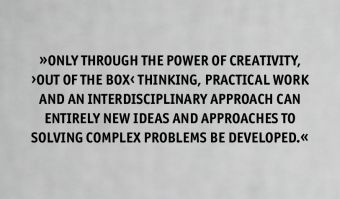
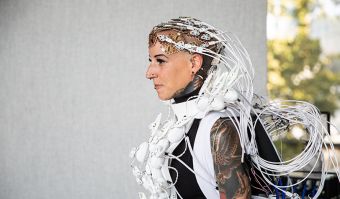
The Pangolin Scales shows how new, groundbreaking inventions can be created through the collaboration of art and science. The work was realised as part of the LIT Special Call Ars Electronica of the Johannes Kepler University Linz in 2020. The call promotes the shaping of innovative ideas through the collaboration of science and art. The Pangolin Scales features an extraordinary scale dress that moves and interacts with its environment, controlled solely by the wearer’s power of thought. This is made technically possible by a world-first, 1,024-channel brain-computer interface (BCI) that is capable of extracting information from the human brain with unprecedented resolution. It was developed by researchers at JKU’s Institute of Integrated Circuits and brain-computer interface experts at g.tec medical engineering GmbH. The impetus and inspiration for the project was provided by fashion tech designer Anouk Wipprecht, who also participated in the development. The LIT Special Call Ars Electronica Festival has been held annually since 2020.
Photo: The Pangolin Scales / Thomas Faseth (AT), Harald Pretl (AT), Christoph Guger (AT), Anouk Wipprecht (NL)
This project is part of LIT-Projects, JKU Campus. The Pangolin Scales demonstrates the world’s first 1.024 channel brain-computer interface (BCI), which is able to extract information from the human brain with an unprecedented resolution to control an interactive, fashionable dress. For further information please visit: https://ars.electronica.art/keplersgardens/en/the-pangolin-scales/
Copyright Information: Tom Mesic
Harnessing the potential of art in reshaping the European economy, in line with the goals formulated in the EU Green Deal and New European Bauhaus, is the central concern of the 12 S+T+ARTS residencies planned for 2021/22. Together with external experts from science, society, politics and business, artists will be invited to act as catalysts for change and develop concepts for a sustainable future.
As a creator of new ideas, a mediator between science and society, and a facilitator of creative, social and communicative skills, art holds enormous potential for research and education. In view of current fields of action, a closing of ranks between science and art is urgently needed, and the potential that their entanglement holds must be exploited.
References
TRANSFORM – Digital and Social Transformation through New Directions in Research and University Education is a cooperative project of Johannes Kepler University Linz, University of Applied Arts Vienna, Danube University Krems and Ars Electronica, financially enabled by the Austrian Federal Ministry of Education, Science and Research.
Zur Website
Manifest Innovation durch Universitas – written by Johannes Kepler University and the University of Applied Arts
See here: www.jku.at/en/manifest
The Pangolin Scales (2020)
Information & Videos at: Ars Electronica Festival 2020; Institutswebsite
All LIT Specialcall Ars Electronica Projects 2020: https://www.jku.at/ars-electronica-2020-in-keplers-garden/
All LIT Specialcall Ars Electronica Projects 2021: https://www.jku.at/ars-electronica-2021-a-new-digital-deal/
S+T+ARTS Regional Centres | Repairing the Present (2021/22)
The Johannes Kepler University is a scientific partner in the Challenge nº2: Circular Futures.
Sources
European Commission (2021): Commission work programme 2022. Making Europe stronger together.
Online at: https://ec.europa.eu/info/sites/default/files/cwp2022_en.pdf
Frey, Carl Benedikt; Osborne, Michael (2013): The Future of Employment: How susceptible are jobs to computerisation?
In: Oxford Martin School, 01.09.2013. Online at: https://www.oxfordmartin.ox.ac.uk/publications/the-future-of-employment/, zuletzt geprüft am 04.11.2020.
Gabriel, Gottfried (2017): Kreativität und Interdisziplinarität in den Wissenschaften.
In: Hanna Kauhaus und Norbert Krause (Hg.): Fundiert forschen. Wissenschaftliche Bildung für Promovierende und Postdocs. Wiesbaden: Springer VS, S. 191–201.
Needle, Andrew; Corbo, Christopher; Wong, Denise; Greenfeder, Gary; Raths, Linda; Fulop, Zoltan (2007): Combining Art And Science In „Arts and Sciences“ Education. In: College Teaching 55 (3), S. 114–120.
OECD (Hg.) (2020): OECD Lernkompass 2030 OECD-Projekt Future of Education and Skills 2030 – Rahmenkonzept des Lernens. Unter Mitarbeit von Bertelsmann Stiftung, Deutsche Telekom Stiftung, Education Y e.V., Global Goals Curriculum e.V., Siemens Stiftung.
Universities UK (2018): Solving future skills challenges.
Online at: https://dera.ioe.ac.uk/32069/1/solving-future-skills-challenges.pdf.
World Economic Forum (2018): The Future of Jobs Report 2018.
Online at: https://www3.weforum.org/docs/WEF_Future_of_Jobs_2018.pdf.
Kerstin Pell
Kerstin Pell works at the Vice Rector for Innovation and Researchers* at JKU and coordinates projects at the interface between art and science. She is responsible for the project „TRANSFORM – Digital and Social Transformation through New Paths in Research and University Education“ in cooperation with the University of Applied Arts Vienna and the Danube University Krems. Before that she worked in the educational and cultural sector.
Picture © JKU / Florian Voggeneder

Christopher Lindinger
Christopher Lindinger has been concerned with the social impact of new technologies and the associated cultures of innovation for more than two decades. He is considered a founding member of the Ars Electronica Futurelab and was responsible for R&D activities as co-director of the lab. Since 2019, he has been Vice Rector for Innovation and Researchers* at JKU.
Picture © JKU / Florian Voggeneder
